User Manual
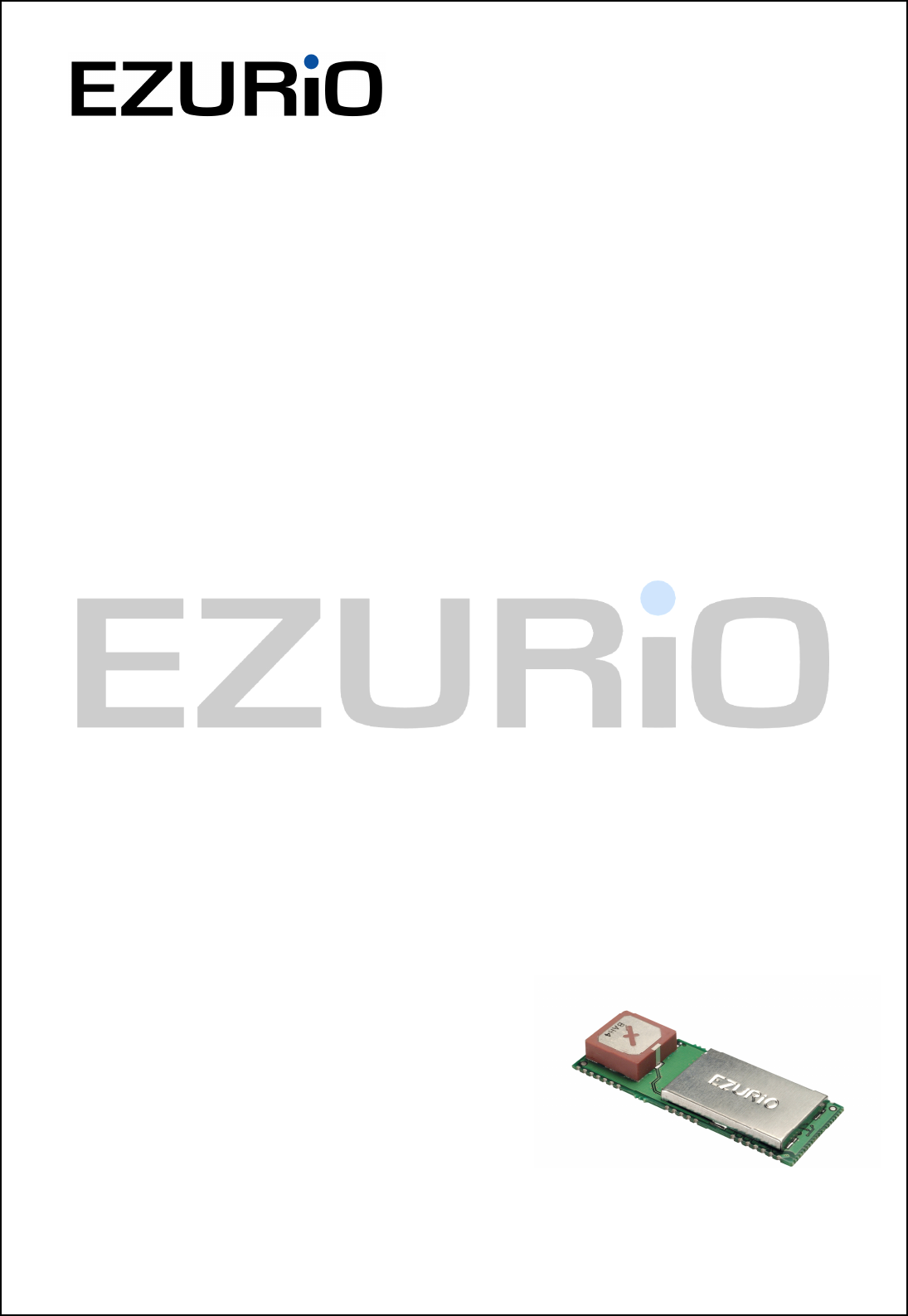
www.ezurio.com DSH_BT024-00200_1v5 © Ezurio Ltd 2006 1
Embedded Intelligent Bluetooth™ Serial Module
Part Number: BISMS02BI-01
1. General Description
Ezurio’s Embedded Intelligent Bluetooth Serial Module is a fully integrated and qualified Class 1 Bluetooth solution
designed for lowest cost of integration and ownership for designers wishing to include Bluetooth functionality in
their products. The module is qualified to Bluetooth Version 2.0.
The Embedded Intelligent Bluetooth Serial Module is designed to give a rugged solution that is ideal for industrial
automation and ruggedised handheld devices. It works over a wide temperature range of -40°C to +85°C. The
physical form of the module allows designers to mount the antenna section of the module outside a screened
enclosure.
The Embedded Intelligent Serial Module is based on Cambridge Silicon Radio’s BlueCore4 chipset. The module
contains all of the hardware and firmware for a complete Bluetooth solution, requiring no further components.
The Module has an integrated, high performance antenna which is matched with the Bluetooth RF and baseband
circuitry. The firmware integrated into the module implements the higher layer Bluetooth protocol stack, up to
and including the Generic Access Profile (GAP), Service Discovery Profile (SDAP), Serial Port Profile (SPP) and
Audio Gateway. A virtual processor is used within the BC04 to implement an AT command processor. This
interfaces to the host system over a straight forward serial port using an extensive range of AT commands. The
AT command set abstracts the Bluetooth protocol from the host application, saving many months of programming
and integration time. It provides extremely short integration times for data oriented cable replacement and voice
applications. A low cost development system and integrated RS232 products with the same firmware are
available for fast product evaluation and development.
An alternative version of firmware is available that provides support for multi-point applications.
The Module can be configured so that it can be attached to a ‘dumb’ terminal or attached to a PC or PDA for cable
replacement applications.
In addition to the Bluetooth functionality, The Embedded Intelligent Serial Module provides access to 6 General
I/O lines and one ADC input. These can be configured to extend the UART control or to provide connection to
simple devices such as switches or LEDs without requiring any external processing. The GPIO lines can be
accessed either via the wired host UART connection, or remotely over the Bluetooth link. Support is also provided
for a PCM connection to an external audio codec.
The Embedded Intelligent Bluetooth Module is supplied in a small form factor PCB (17.7mm x 46.0mm x 5.0mm),
that solders directly. The module includes a high sensitivity, high gain antenna which provides excellent range.
Typical open field performance provides ranges of over 250 metres at transmit powers of 4mW.
Support is provided for low power modes that make the Embedded Intelligent Bluetooth Module particularly
applicable to battery powered installations.
The Embedded Intelligent Bluetooth Module is Lead-free and RoHS compliant and supports an industrial operating
temperature range of -40°C to +85°C.
1.1 Applications
• POS Equipment • Automotive Applications
• Industrial Automation • Telematics
• Vending Equipment • Medical
Bluetooth is a trademark owned by Bluetooth SIG, Inc., USA, and is licensed to Ezurio Ltd

www.ezurio.com DSH_BT024-00200_1v5 © Ezurio Ltd 2006 2
2. Features
Feature Implementation
Bluetooth Transmission Class 1
Fully Bluetooth pre-qualified Bluetooth 2.0
Range 250 metres typical (free space)
Frequency 2.400 – 2.485 GHz
Max Transmit Power +6dBm
Min Transmit Power -27dBm
Receive Sensitivity Better than -86dB
Data Transfer rate Up to 300Kbps over UART.
Serial Interface RS-232 bi-directional for commands and data using AT commands
Serial parameters Default 9600,n,8,1 - Configurable from 1,200bps to 961,200 bps.
7 bit firmware is available – please contact Ezurio
Support for DTR, DSR, DCD, RI, RTS, CTS
Physical size 17.7mm x 46.0mm x 5.0mm, 8g
Current consumption Less than 36mA during data transfer in standard power mode. Lower powers
are attainable with a configurable low power mode.
Low power sniff mode 2.5mA typ
Temperature Range Normal operation: -40°C to +85°C
Supply Voltage 3.3V – 7.0V
Interface Levels 3.0V Logic
Audio Audio can be transferred over SCO channels through the PCM interface at
64kbps. PCM can be configured as master or slave.
Support for dual slave PCM connections.
Profiles Server - SPP (Full), DUN, Audio Gateway, Headset, Handsfree
Client - All RFCOMM based profiles
Multipoint Max 7 slaves with multipoint
Field upgradeable Over UART
Protocols Single point firmware is controlled and configured using AT Commands.
Standard multipoint firmware uses a simple packet based protocol and
requires a host to enable the module to function effectively.
Single point only allows a point to point connection whereas multipoint allows
more than one simultaneous connection.
GPIO 6 x digital (DTR can also be allocated as GPIO)
ADC 1 x 8 bit
Indicators Pads for 2 programmable LEDs
Lead free Lead-free and RoHS compliant
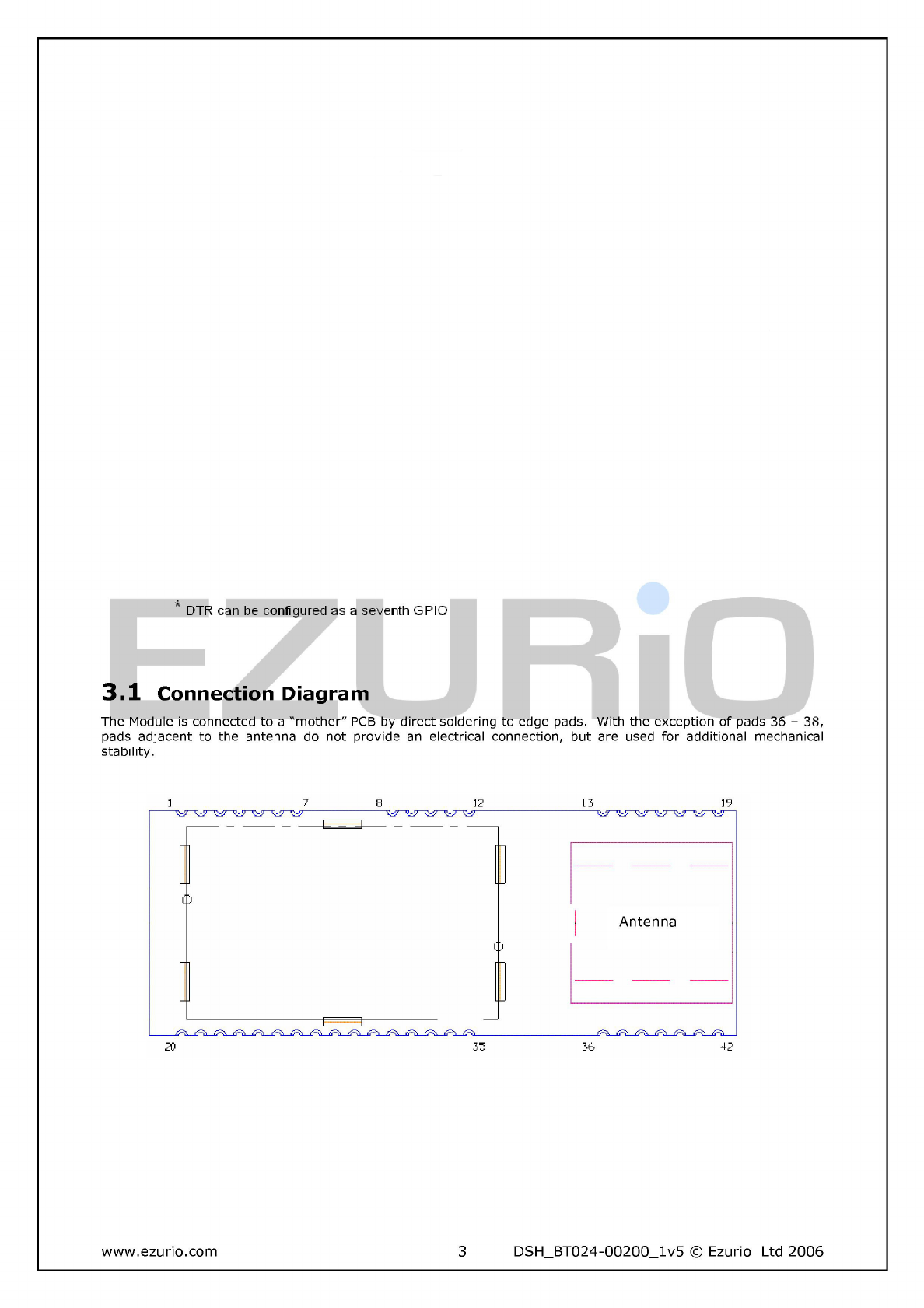
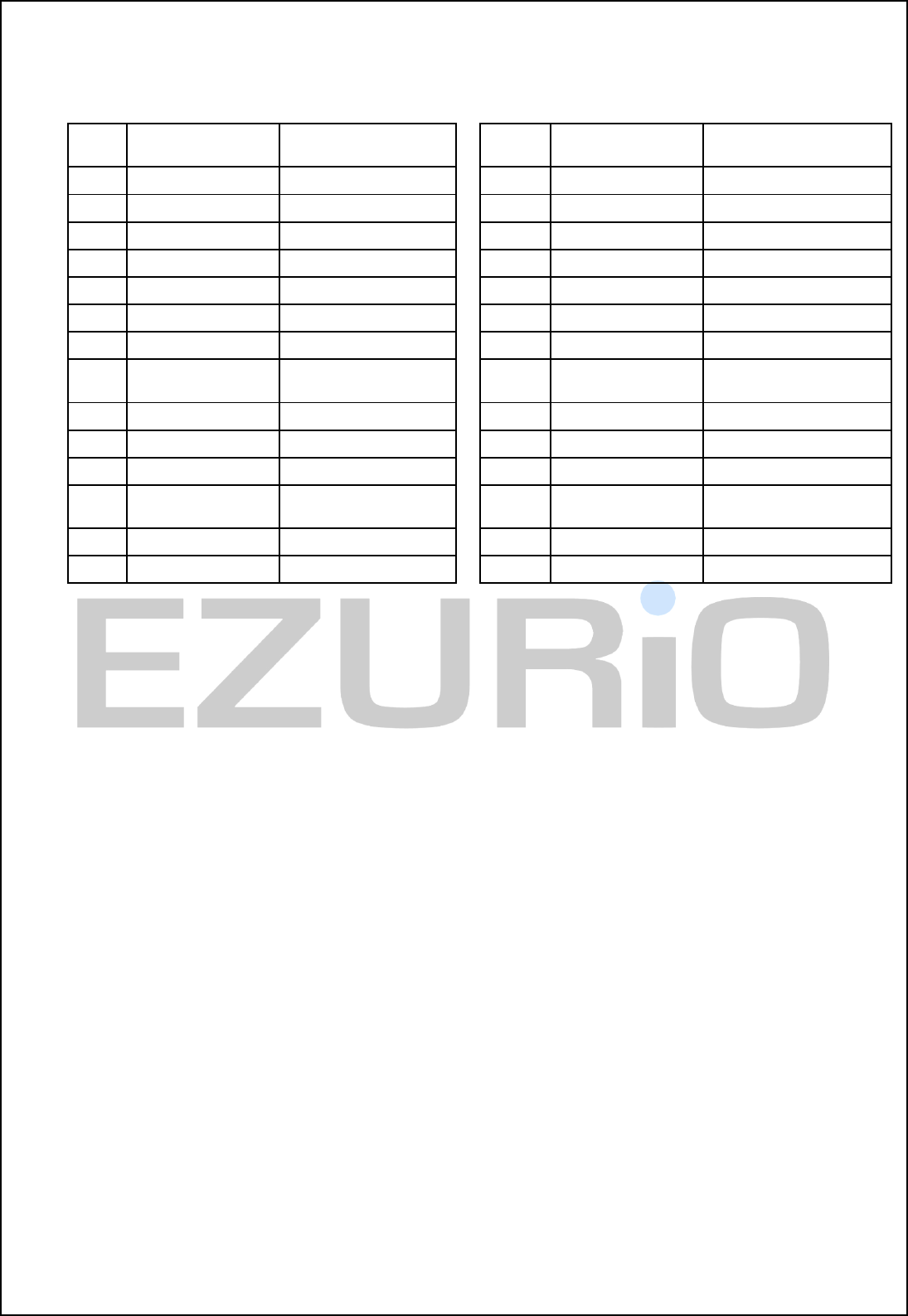
www.ezurio.com DSH_BT024-00200_1v5 © Ezurio Ltd 2006 4
3.2 Pin Descriptions
The table below defines the pin functions. Refer to the previous section for the pin location
Pin
No.
Signal Description Pin
No.
Signal Description
1 VCC 2 USB /RESERVED Do not connect
3 USB /RESERVED Do not connect 4 GND
5 RESET- Reset I/P * 6 GPIO_6 I/O for Host
7 GPIO_7 I/O for Host 8-19 N/C Do not Connect
20 GND 21 UART_DCD I/O for Host
22 UART_RI I/O for Host 23 UART_RTS Request to Send O/P
24 UART_RX Receive Data I/P 25 UART_CTS Clear to Send I/P
26 UART_TX Transmit Data O/P 27 UART_DTR
(GPIO_3)
I/O for Host
28 UART_DSR Input 29 GND
30 PCM_SYNC PCM Sync I/P 31 PCM_IN PCM Data I/P
32 PCM_CLK PCM Clock I/P 33 PCM_OUT PCM Data O/P
34 GPIO_9
PCM_SLVCLK
I/O for Host (Slave
PCM Clock)
35 GPIO_5 I/O for Host (LED2)
36 GPIO_4 I/O for Host (LED1) 37 Analogue_0 ADC
38 GPIO_8 I/O for Host 39-42 N/C Do not connect
Notes:
* The reset line has a fixed 10kOhm pull up resistor with the reset being active low.
PIO lines can be configured through software to be either inputs or outputs with weak or strong pull-ups or pull-
downs. At reset, all PIO lines are configured as inputs with weak pull-downs.
UART_RX, UART_TX, UART_CTS, UART_RTS, UART_RI, UART_DCD and UART_DSR are all 3.0v level logic. For
example, when RX and TX are idle they will be sitting at 3.0V. Conversely for handshaking pins CTS, RTS, RI,
DCD, DSR a 0v is treated as an assertion.
Pin 22 (UART_RI) is active low. It is normally 3.0v. When a remote device initiates a connection, this pin goes
low. This means that when this pin is converted to RS232 voltage levels it will have the correct voltage level for
assertion.
Pin 21 (UART_DCD) is active low. It is normally 3.0v. When a connection is live this pin is low. This means that
when this pin is converted to RS232 voltage levels it will have the correct voltage level for assertion.
Pin 28 (UART_DSR) is an input, with active low logic. It should be connected to the DTR output of the host. When
the Module is in high speed mode (See definition for S Register 507), this pin should be asserted by the host to
ensure that the connection is maintained. A deassertion is taken to mean that the connection should be dropped,
or an online command mode is being requested.
The GPIO pins can be accessed using S Registers in the range 623 to 629. GPIO4 and 5 are connected to
unpopulated LED pads on the module. If these I/O pins are set for input, then the LED will be driven by the host
and appropriate drive current requirements must be satisfied. A Logic 1 switches on the LED.
GPIO3 is shares the pin with DTR output (active low). See S Register 552 & 553.
Analogue 0 input should not exceed 1.8v. S Register 701 is used to access it.
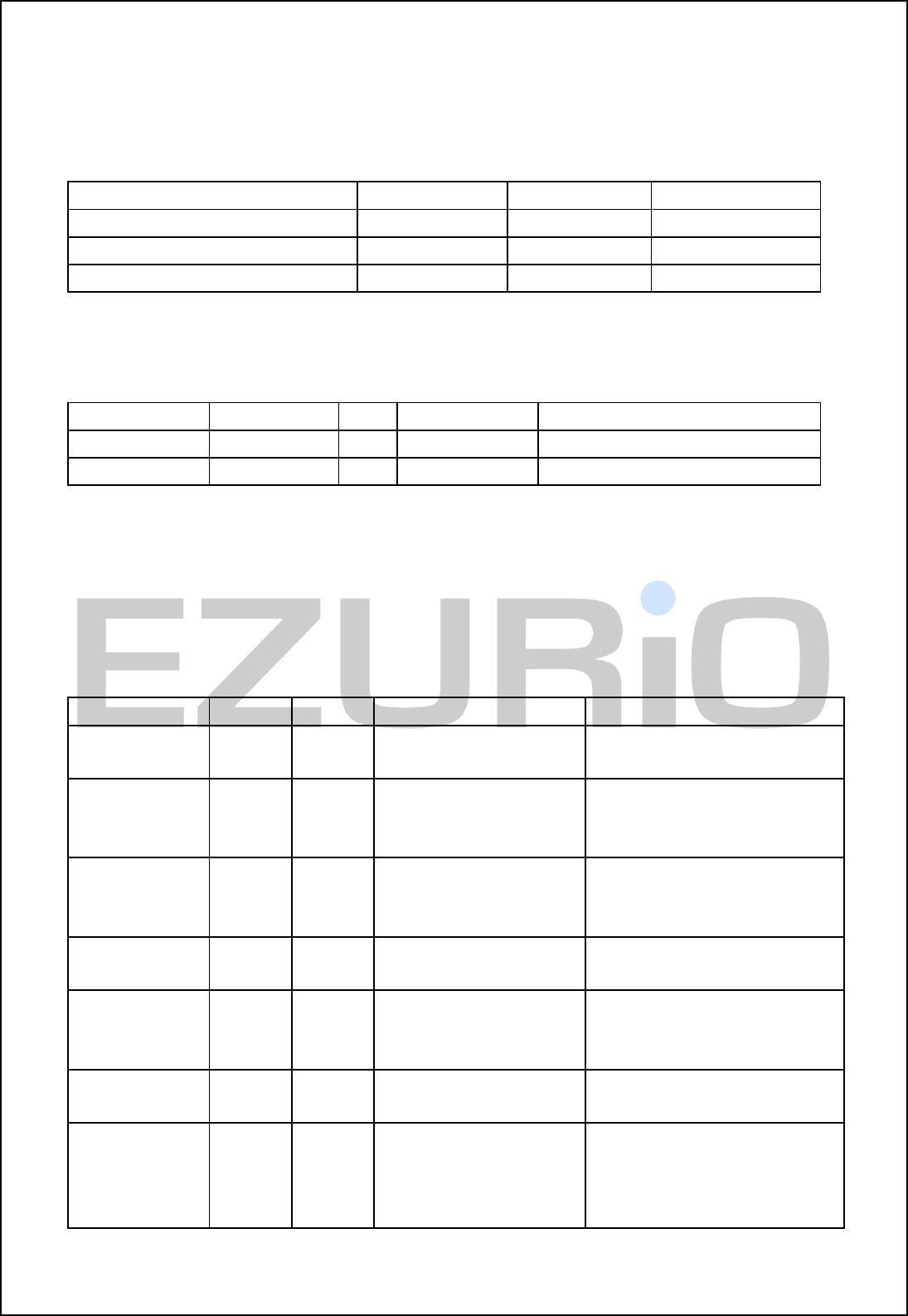
www.ezurio.com DSH_BT024-00200_1v5 © Ezurio Ltd 2006 5
3.3 Electrical Specifications
3.3.1 Absolute Maximum ratings
Absolute maximum ratings for supply voltage and voltages on digital and analogue pins of the Module are listed
below; exceeding these values will cause permanent damage.
Parameter Min Max Unit
Peak current of power supply 0 100 mA
Voltage at digital pins -0.3 3.3 V
Voltage at POWER pin 3.3 7 V
3.3.2 Recommended Operating Parameters
3.3.2.1 Power Supply
Signal Name Pin No I/O Voltage level Comments
Vcc 1 I 3.3V to 7.0V Ityp = 30mA
GND 4, 20, 29
The module contains a power on reset circuit that ensures the module is reset at power on. The internal reset
circuit is triggered when the input voltage to the module drops below ~1.7V and is hence only suitable for
providing a power on reset signal. If the supply voltage to the module can drop below the minimum voltage level
in normal operation, then it is recommended that an external brownout circuit is provided to assert the module
reset and to ensure that the module is reset when the module supply voltage drops below 3.1V.
This will ensure that the module will return to an operational state when the supply voltage comes back within
specification. For example, if the module supply can drop to 2.7V and then be restored to 3.3V there is no
guarantee that the module will still be operational unless the reset signal has been asserted.
3.3.2.2 RS-232 Interface
Signal Name Pin No I/O Signal level Comments
UART_TX 26 O VOLmax=0.2V
VOHmin=2.8V
UART_RX 24 I VILmax=0.8V
VIHmin=2.1V
VIHmax=3.4V
UART_CTS 25 I VILmax=0.8V
VIHmin=2.1V
VIHmax=3.4V
UART_RTS 23 O VOLmax=0.2V
VOHmin=2.8V
UART_DSR 28 I VILmax=0.8V
VIHmin=2.1V
VIHmax=3.4V
UART_DTR 27 O VOLmax=0.2V
VOHmin=2.8V
Shared with GPIO_3
UART_RI 22 I or O O/P : VOLmax=0.2V
VOHmin=2.8V
I/P : VILmax=0.8V
VIHmin=2.1V
Direction may be programmed.
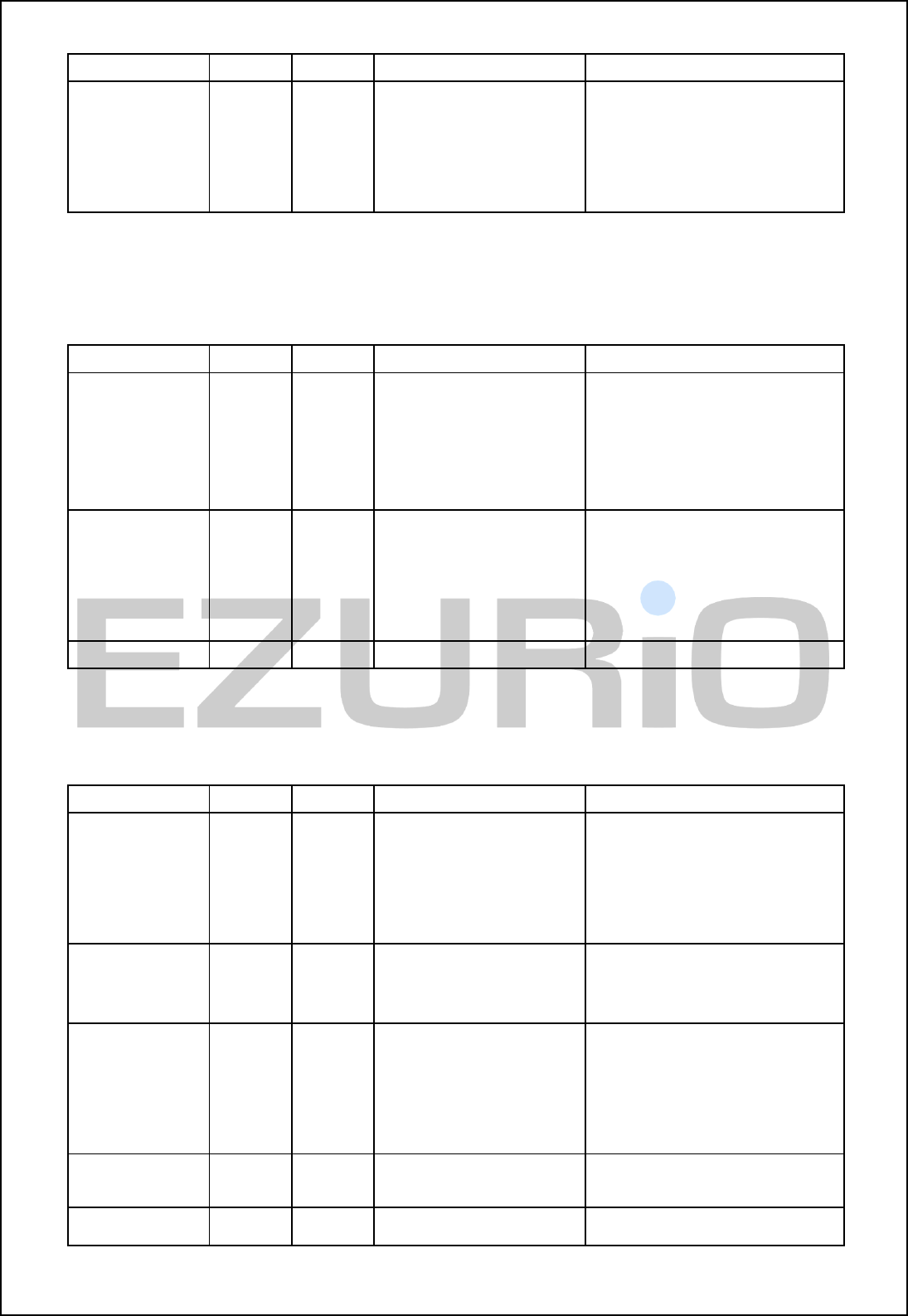
www.ezurio.com DSH_BT024-00200_1v5 © Ezurio Ltd 2006 6
VIHmax=3.4V
UART_DCD 21 I or O O/P : VOLmax=0.2V
VOHmin=2.8V
I/P : VILmax=0.8V
VIHmin=2.1V
VIHmax=3.4V
Direction may be programmed.
UART_RX, UART_TX, UART_CTS, UART_RTS, UART_RI, UART_DCD and UART_DSR are all 3.0v level logic. For
example, when RX and TX are idle they will be sitting at a nominal 3.0V. Conversely for handshaking pins CTS,
RTS, RI, DCD, DSR a 0v is treated as an assertion.
3.3.2.3 General Purpose I/O and ADC
Signal Name Pin No I/O Signal level Comments
GPIO 4, 5, 6, 7,
8, 9
36, 35,
6, 7, 38,
34
I or O O/P : VOLmax=0.2V
VOHmin=2.8V
I/P : VILmax=0.8V
VIHmin=2.1V
VIHmax=3.4V
GPIO_4 and 5 are shared with the
onboard LED pads.
GPIO_9 is also used for
PCM_SLVCLK.
GPIO 3 27 I or O O/P : VOLmax=0.2V
VOHmin=2.8V
I/P : VILmax=0.8V
VIHmin=2.1V
VIHmax=3.4V
Shared with DTR
ADC 0 37 I Range 0 – 1.8V ADC
PIO lines can be configured through software to be either inputs or outputs with weak or strong pull-ups or pull-
downs. At reset, all PIO lines are configured as inputs with weak pull-downs.
3.3.2.4 PCM Interface
Signal Name Pin No I/O Signal level Comments
PCM_CLK 32 I or O O/P : VOLmax=0.2V
VOHmin=2.8V
I/P : VILmax=0.8V
VIHmin=2.1V
VIHmax=3.4V
If unused keep pins open
PCM_IN 31 I VILmax=0.8V
VIHmin=2.1V
VIHmax=3.4V
PCM_SYNC 30 I or O O/P : VOLmax=0.2V
VOHmin=2.8V
I/P : VILmax=0.8V
VIHmin=2.1V
VIHmax=3.4V
PCM_OUT 33 O VOLmax=0.2V
VOHmin=2.8V
PCM_SLV_CLK O O/P : VOLmax=0.2V Available as a clock when two
connected devices are both in PCM
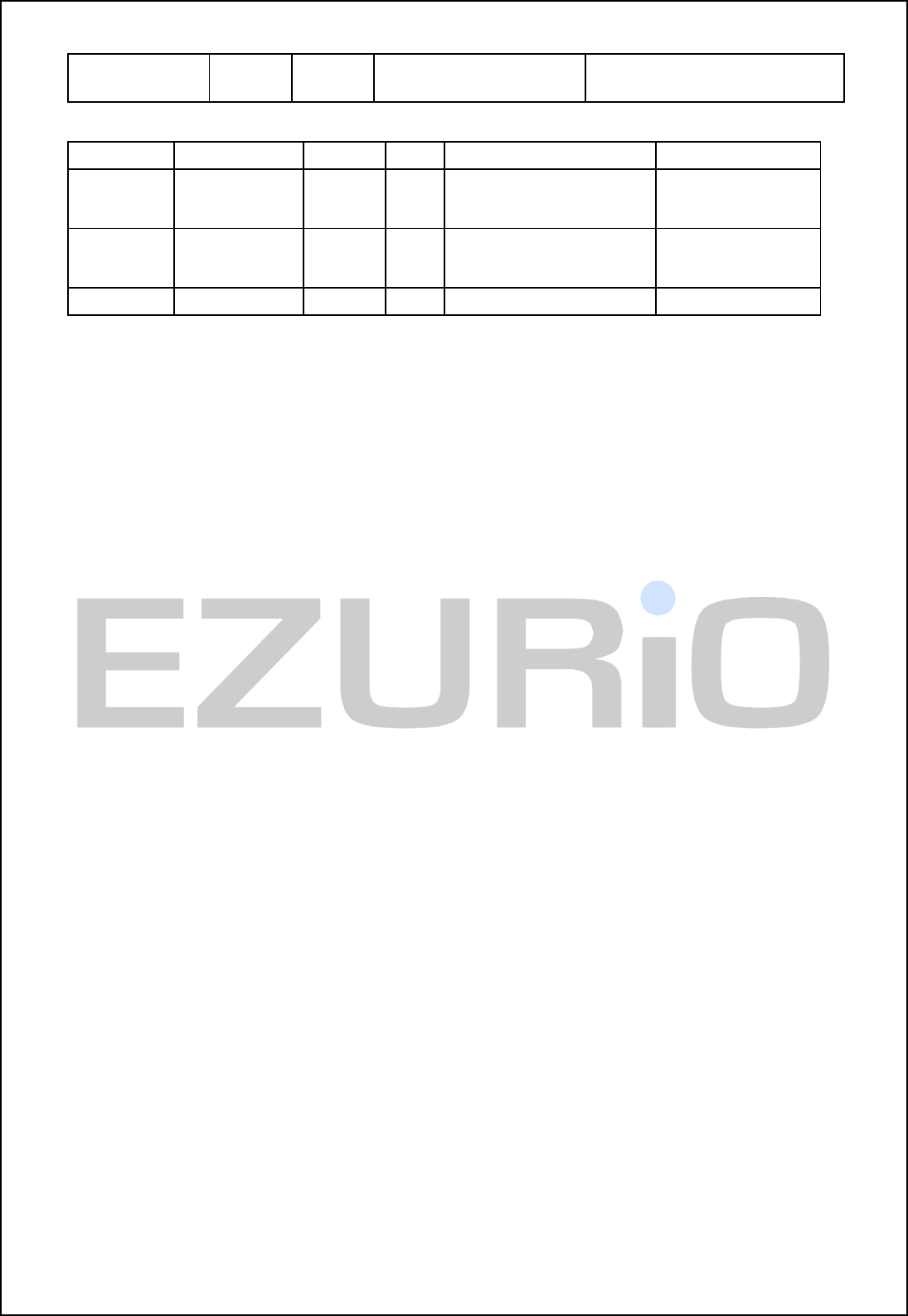
www.ezurio.com DSH_BT024-00200_1v5 © Ezurio Ltd 2006 7
(GPIO9) VOHmin=2.8V slave mode.
Shared with GPIO_9
3.3.2.5 Miscellaneous
Function Signal Name Pin No I/O Signal level Comments
Reserved USB D- 3 I VILmax =0.3vdd_usb
VIHmin =0.7vdd_usb
Normally inactive.
Pull to GND through
10K
Reserved USB D+ 2 I VILmax =0.3vdd_usb
VIHmin =0.7vdd_usb
Normally inactive.
Pull to GND through
10K
Reset RESET 5 I Threshold 2.6V Active LOW
Terminology:
USB Signal Levels. vdd_usb refers to the internal voltage generated by the LDO regulator on the module, which
is typically 3.1V. Hence 0.3vdd_usb and 0.7vdd_usb correspond to 0.9 V to 2.1V. If Vcc falls below the
recommended minimum of 3.3V, USB operation cannot be guaranteed.
The USB lines cannot be accessed when using AT firmware.
4. I/O Characteristics
4.1 Power Consumption
The current drain from the Vcc power input line is dependent on various factors. The three most significant factors
are the voltage level at Vcc, UART Baudrate and the operating mode.
The hardware specification for the Module allows for a voltage range of 3.3 to 7.0 at Vcc. Tests have shown that
where power drain is an issue, it is best to keep Vcc at the lower end of the range.
The UART Baudrate has a bearing on power drain because as is normal for digital electronics, the power
requirements increase linearly with increasing clocking frequencies. Hence higher baudrates result in a higher
current drain.
Finally with regards to operating mode the significant modes are; idle, waiting for a connection, inquiring,
initiating a connection, sniff and connected. With connected mode, it is also relevant to differentiate between no
data being transferred and when data is being transferred at the maximum rate possible. The AT command Set
document describes how to configure the Module for optimal power performance.
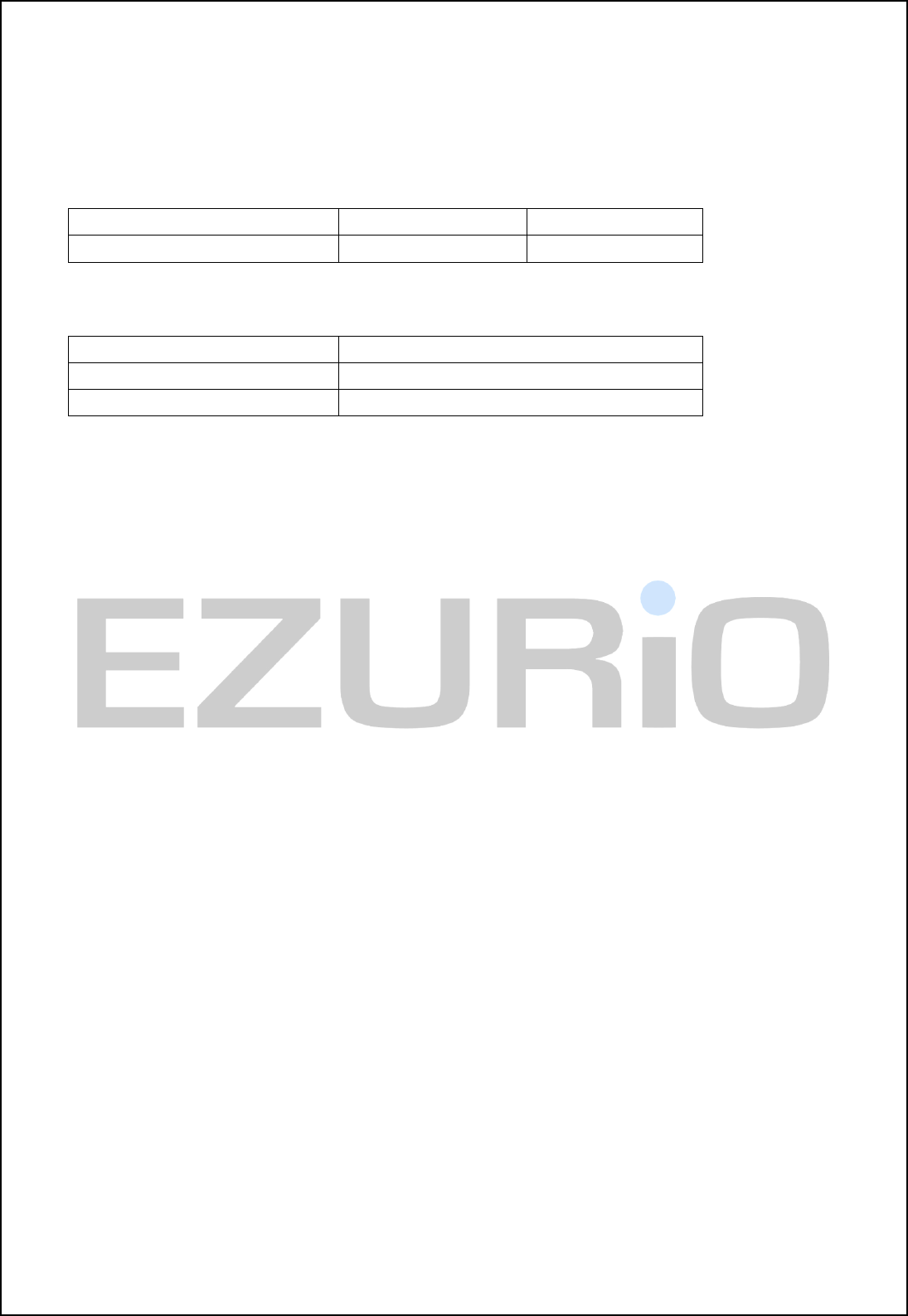
www.ezurio.com DSH_BT024-00200_1v5 © Ezurio Ltd 2006 8
5. DC Characteristics
5.1 RF Performance
5.1.1 Transmit Power
Conducted Transmit Power min: 1.0mW (0dBm) max: 4mW (6dBm)
Effective Transmit Power min:0dBm Max: +6dBm
Output power can be reduced by program control
5.1.2 Receive Sensitivity
Receive Sensitivity -86dBm (at 25°C)
Antenna Gain +2dBi typ
Effective Receive Sensitivity -88dBm (at 25°C)
5.2 Range
Range is determined by the environment and the orientation of the module.
The data throughput of the Module is limited to 300Kbps by the parsing of the data being transferred through the
RFCOMM stack.
6. Functional Description
The Embedded Intelligent Bluetooth module is a self-contained Bluetooth product and requires only power to
implement full Bluetooth communication. The integrated, high performance antenna together with the RF and
Base-band circuitry provides the Bluetooth wireless link and the UART interface provides a connection to the host
system.
The variety of interfaces and the AT command set allow the Embedded Intelligent Bluetooth Module to be used for
a wide number of short range wireless applications, from simple cable replacement to complex multipoint
applications, where multiple radio links are active at the same time.
The complexity and flexibility of configuration are made simple for the design engineer by the integration of an
extremely comprehensive set of AT commands, supplemented with a range of “S” registers which are used for
non-volatile storage of system parameters. These are fully documented in the “Blu2i AT Command Reference
Manual”.
6.1 Interfaces
6.1.1 UART interface
UART_TX, UART_RX, UART_RTS and UART_CTS form a conventional asynchronous serial data port with
handshaking. The interface is designed to operate correctly when connected to other UART devices such as the
16550A. The signalling levels are nominal 0V and 3.0V and are inverted with respect to the signalling on an
RS232 cable. The interface is programmable over a variety of baud rates; no, even or odd parity. The default
condition on power-up is pre-assigned in the external Flash. Two-way hardware flow control is implemented by
UART_RTS and UART_CTS. UART_RTS is an output and is active low. UART_CTS is an input and is active low.
These signals operate according to normal industry convention.
By writing different values to the relevant S register the UART_RI can be continuously polled to detect incoming
communication. The UART_RI signal serves to indicate incoming calls.
UART_DSR is an active low input. It should be connected to DTR output of the host. When the module is running
in high speed mode (See definition for S Reg 507), this pin should be asserted by the host to ensure connection is
maintained. A de-assertion is taken to mean that the connection should be dropped, or an online command mode
is being requested.
The module communicates with the customer application using the following signals:
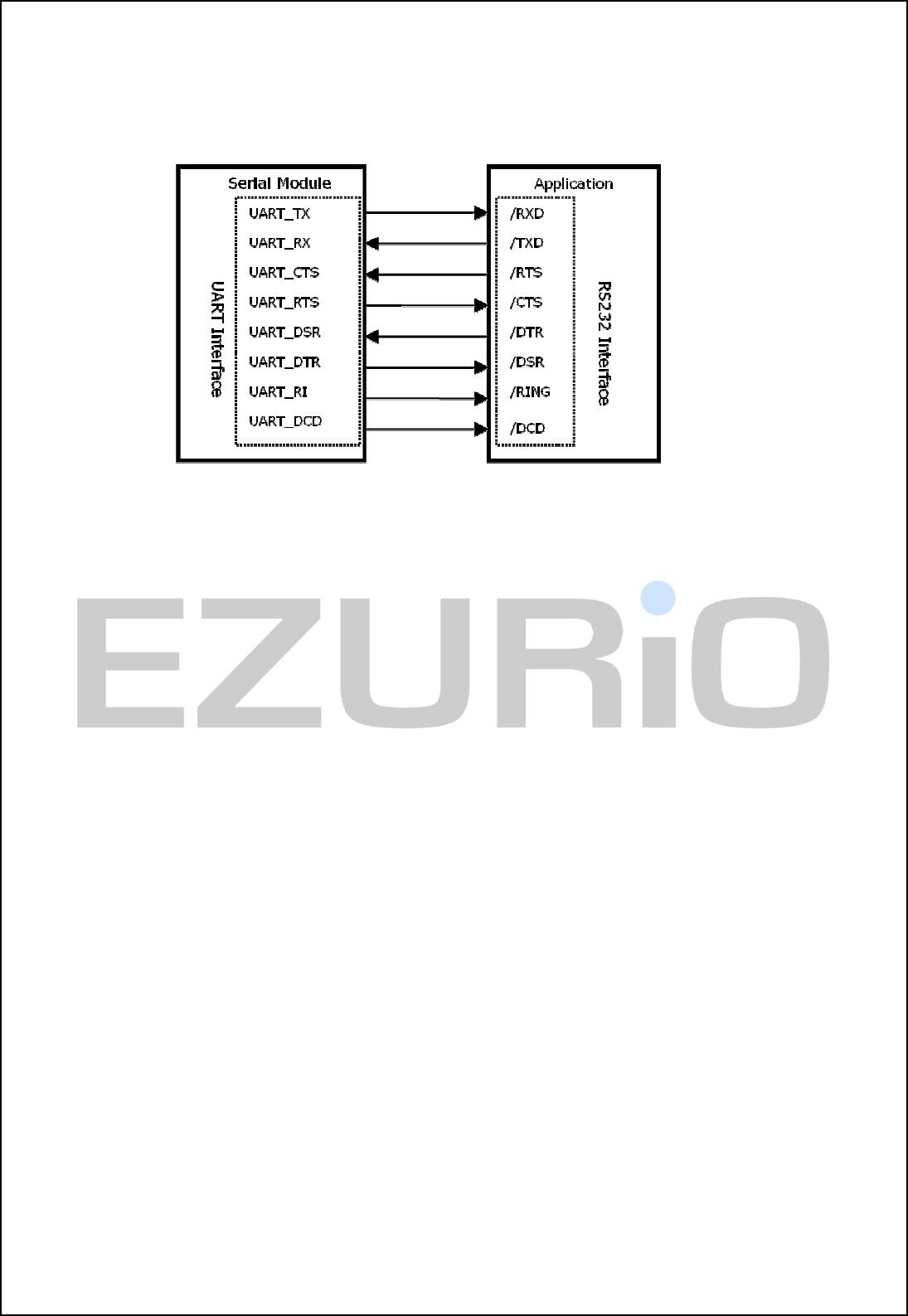
www.ezurio.com DSH_BT024-00200_1v5 © Ezurio Ltd 2006 9
RS-232
Port /TXD @ application sends data to the module’s UART_RX signal line
Port /RXD @ application receives data from the module’s UART_TX signal line
Figure 6.1 : UART interfaces
Note that the serial module output is at 3.0V CMOS logic levels. Level conversion must be added to interface with
an RS-232 level compliant interface.
6.1.2 GPIO Port
Eight lines of programmable bi-directional input/outputs (I/O) are provided that can be accessed either via the
UART port, or Over The Air (OTA) from a second Bluetooth unit. These can be used as data inputs or to control
external equipment. By using these in OTA mode, an embedded Bluetooth Serial module can be used for control
and data acquisition without the need for any additional host processor. A further line can be used as an input.
Each of the GPIO ports can be independently configured to be either an Input or Output. A selection of ports can
be accessed synchronously.
The ports are powered from VCC. The mode of these lines can be configured and the lines are accessed via S
Registers in the range 623 to 629.
Low latency I/O can be accessed by using Ezurio’s I/O via an enhanced inquiry process.
6.1.3 PCM CODEC Interface
PCM_OUT, PCM_IN, PCM_CLK and PCM_SYNC carry up to three bi-directional channels of voice data, each at
8ksamples/s. The format of the PCM samples can be 8-bit A-law, 8-bit µ-law, 13-bit linear or 16-bit linear. The
PCM_CLK and PCM_SYNC terminals can be configured as inputs or outputs, depending on whether the module is
the Master or Slave of the PCM interface.
In applications where the PCM master cannot supply a clock signal, the module can be configured to generate a
clock signal on this GPIO: PCM_SLVCLK. Please contact an Ezurio FAE for further details.
The Module is compatible with the Motorola SSI TM interface and interfaces directly to PCM audio devices
including the following:
6.1.3.1 Compatible Codec Chips
• Qualcomm MSM 3000 series and MSM 5000 series CDMA baseband devices
• OKI MSM7705 four channel A-law and µ-law CODEC
• Motorola MC145481 8-bit A-law and µ-law CODEC
• Motorola MC145483 13-bit linear CODEC

www.ezurio.com DSH_BT024-00200_1v5 © Ezurio Ltd 2006 10
6.1.4 ADC
The module provides access to one 8-bit ADC. This provides an input range of 0mV to 1,800mV, which can be
read using S register 701.
Suitable external scaling and over-voltage protection should be incorporated in your design. The module provides
5 samples per second at the UART with a baud rate of 115,200 or above.
Low latency access of the upper 6 bits of the ADCs can be obtained by using Ezurio’s I/O via an enhanced inquiry
process.
6.1.5 LEDs
Pads are provided to allow two LEDs to be added for diagnostic purposes. They are controlled by an S registers
624 and 625 to display the status of various parameters and are useful for debug and test.
7. Integrated Firmware
7.1 General
The Embedded Intelligent Serial Module has been designed to provide the fastest route to market for designers
who wish to use Bluetooth to wirelessly enable their products. To achieve this Ezurio has implemented a wide
ranging set of AT commands that control all of the standard Bluetooth tasks. These remove the complexity of
Bluetooth from the design engineer and allow the wireless link to be controlled by means of a simple set of
commands.
For applications where multiple concurrent live connections need to be maintained a variant of firmware is
available which is specifically targeted at multipoint operation.
For both applications a comprehensive range of windows based software is available to speed up the design
process. A low cost development kit is also available that can be used for prototyping both cable replacement
and multipoint applications.
7.2 Profiles
Bluetooth has been designed to accommodate a very wide range of wireless applications. To enable these
different applications the Bluetooth SIG (Special Interest Group) has defined a series of different profiles that
define the way in which Bluetooth devices communicate with each other and perform basic functions. These
provide a base line of interoperability for specific application scenarios, upon which more complex user
applications can be developed.
There are over 30 different profiles, many of which have been developed for specific applications. The Embedded
Intelligent Serial Module firmware is provided with support for the profiles that are most commonly required for
cable replacement applications.
The current profiles support includes:
GAP Generic Access Profile The base connection profile upon which others are based.
SDP Service Discovery Profile The profile to find other Bluetooth devices and the services
they support.
SPP Emulation of a serial cable for cable replacement applications.
DUN Dial Up Networking Profile support for connection to an external PSTN, GSM, GPRS
or VPN connection.
AG Audio Gateway The base element for Headset and Handsfree profile. A portion
of these profiles must be implemented within the host system.
HSP Headset Profile Supports early implementations of headsets. Now largely
replaced by the:
HFP Hands-free profile which provides more control over the headset operation.
FTP File Transfer Profile (full client support).
For other profile support, please contact EZURiO at blu2i@ezurio.com

www.ezurio.com DSH_BT024-00200_1v5 © Ezurio Ltd 2006 11
7.3 AT Overview
The AT command set is well known by engineers and was developed to aid the integration of PSTN modems. It
provides simple high level commands for complex functions that can easily be incorporated into programs or used
within programming scripts.
Ezurio has used this familiar concept and extended it to Bluetooth to simplify the integration of Bluetooth for
product designers. Rather than having to understand the many stages of setting up a Bluetooth connection or
function, a single AT command is all that is required.
For example to connect to a Bluetooth device with an address 00809844EA13, all that is needed is to send the
string
ATD00809844EA13
to the UART of the Embedded Intelligent Bluetooth Module. The module will attempt to make a connection and
return (connect 00809844ea13,1101) or (NO CARRIER), depending on whether the connection was successful.
The scope of the AT command set developed by Ezurio is such that most Bluetooth functionality can be covered,
greatly reducing development time.
To provide additional functionality a range of “S” registers has been implemented. These allow program settings
to be stored to control the Embedded Intelligent Serial Module function and also give access to configuring and
reading ports and status registers within the Embedded Intelligent Serial Module.
Full details of the AT command set are provided in the Blu2i AT Command Reference Manual.
7.3.1 AT features at a glance
7.3.1.1 General
• Configure two modules to automatically connect and transfer data, audio or a combination of
data and audio when both devices are powered. The peer device does not have to be another Intelligent
Serial Module. It is possible to implement auto connect with a Bluetooth enabled mobile phone.
• Automatically re-connect devices when a connection is dropped.
• Remotely access the AT parser of the remote unit from a master device to perform Over The
Air (OTA) configuration.
• Configure the module to enter a state on power up and after a period of time change to
another state automatically. This allows units to be placed in the discoverable state for a limited time
period.
• Read and write to GPIO lines
• Read the ADC channel
• Get fast GPIO and ADC status through an inquiry response (patent pending)
7.3.1.2 UART
• Change the baud rate from 1200 to 921,600 baud.
• Use the DSR line to drop connections
• Flexible configuration as either DTE or DCE
• Change escape sequence character
• Change the Parity
• Enable or disable echoes
7.3.1.3 Security
• Enable Authentication by requiring a PIN code for incoming AND / OR outgoing connections
• Enable data to be encrypted over the air for incoming AND / OR outgoing
connections. The module can be configured to be:
non-connectable and non-discoverable,
non-connectable but discoverable,
connectable but non-discoverable,
connectable and discoverable.

www.ezurio.com DSH_BT024-00200_1v5 © Ezurio Ltd 2006 12
• Automatically store Paired devices in a trusted device database in the flash memory
7.3.1.4 Bluetooth
• Set the module to be a master or slave
• Make a Bluetooth connection to a specified device
• Perform a full inquiry for other Bluetooth devices
• Query a remote device to check if a service is offered
• Fetch the friendly name of a remote device
• Increase or decrease the delay before the master abandons a connection attempt
• Change the device class code
• Set the device’s friendly name
• Change the Inquiry scan time
• Change number of returned devices from an inquiry scan
• Obtain the RSSI value for a connection
7.3.1.5 Power Management
• Decrease or increase the output power to suit your connection range
• Configure the modules to work in Sniff and other low power modes.
7.4 Multipoint Firmware
For multipoint operation, the appropriate firmware can be enabled. Whereas the firmware for single point ‘AT’
communication only allows one connection to be active at any one time, using multipoint firmware allows a
number of simultaneous connections to be made and maintained. It also allows connections to multiple profiles to
one or more devices. Multipoint firmware should be seen as a concept of channels instead of slave connections.
When operating in Bluetooth multipoint mode, the resources and bandwidth of a Bluetooth master device are
shared amongst the different connected devices. This has an impact on the maximum throughput to any one
device. If multiple device connections are maintained it also impacts on the memory resources and device
database within the Bluetooth stack. Designers should be aware of these restrictions when using multipoint
configurations. In most cases better latency and power consumption can be achieved by polling or fast data
transfer rather than by maintaining concurrent connections.
In general, multipoint connections are viable for up to three connections, but other connection schemes become
appropriate if a greater number of devices are being deployed.
7.5 OTA (Over the Air) Configuration
When the Embedded Intelligent Serial Module has its remote AT parser enabled, its settings can be remotely
controlled by a master unit (see register S536). This places the slave unit’s AT parser in remote mode providing
over the air configuration. This mode is of use for remote sensor applications, where no host processor is
required to control the slave Bluetooth unit.
7.6 Boot modes
The module has the capability of booting into 1 of 4 modes. Currently only Boot Modes 1 and 3 are supported.
Boot Mode 1 is default and gives functionality equivalent to the BISM1 and BISM2 module.
Boot Mode 3 changes the PCM configuration for use with OKI codecs.
These modes will be used to specify alternative PSKEY settings to allow for different basic operation. Please
contact Ezurio for further information.
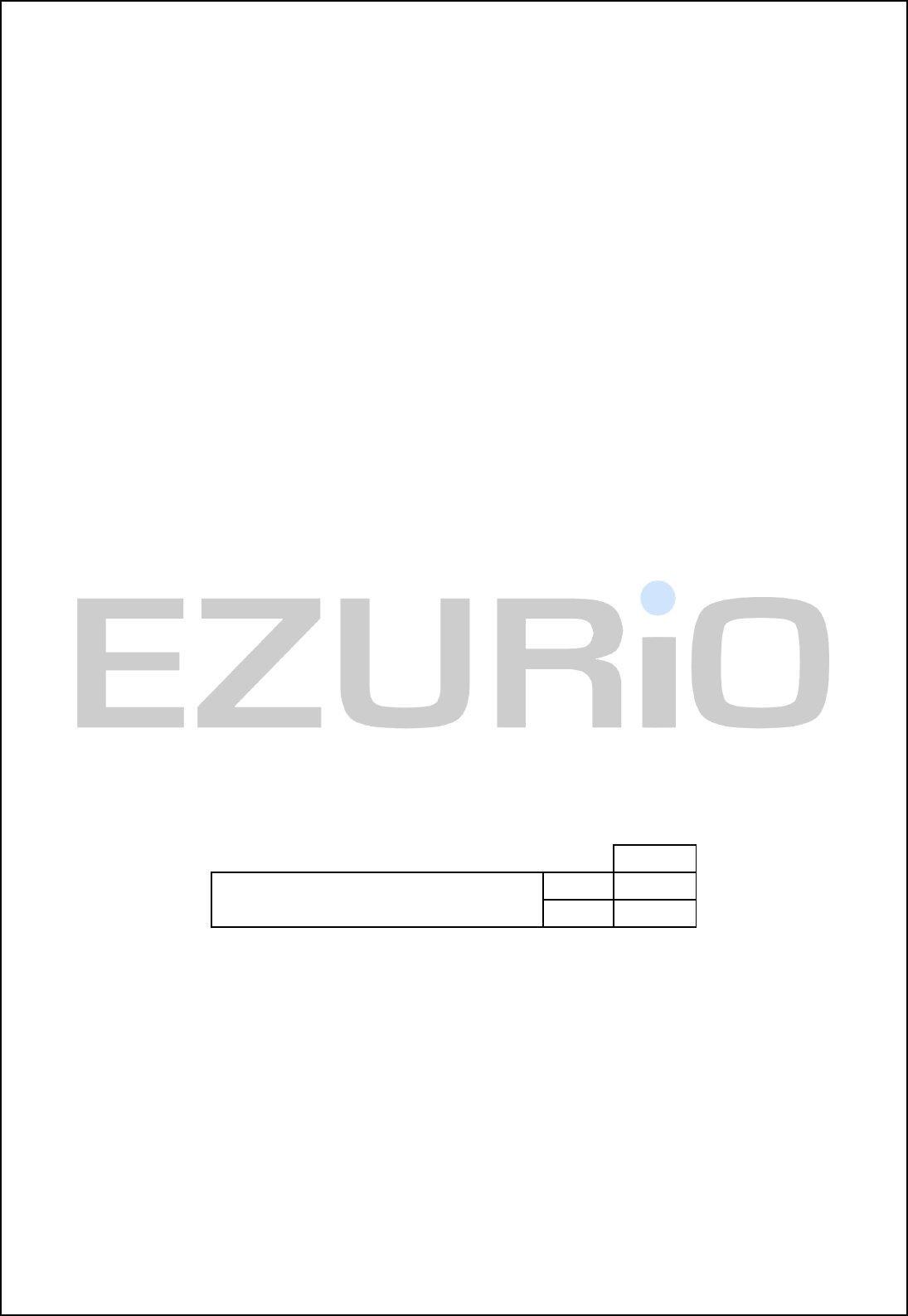
www.ezurio.com DSH_BT024-00200_1v5 © Ezurio Ltd 2006 13
8. Low Power Modes
The current drain from the Vcc power input line is dependent on various factors. The three most significant factors
are the voltage level at Vcc, UART baud rate and the operating mode.
The hardware specification for the Embedded Intelligent Bluetooth Module allows for a voltage range of 3.3 to
7.0v at Vcc. Tests have shown that there is no significant difference in current draw when Vcc is 5 or 6V.
The UART baud rate has a bearing on power drain because as is normal for digital electronics, the power
requirements increase linearly with increasing clocking frequencies. Hence higher baud rates result in a higher
current drain.
Finally with regards to operating mode the significant modes are; idle, waiting for a connection, inquiring,
initiating a connection and connected. With connected mode, it is also relevant to differentiate between no data
being transferred and when data is being transferred at the maximum rate possible.
The operating mode can best be described by stating the AT commands required to enter that mode. In addition,
there are certain S Registers which have a direct impact on power consumption, which are described next.
The Embedded Intelligent Bluetooth Module has provision for an LED which can be configured to display
connection status. Tests have shown that this LED can consume up to 5.3mA which is more than double the
current draw when in Idle mode. S Register 534 can be used to completely disable this indicator.
S Registers 508 to 511, which specify the page and inquiry scan intervals and windows, can be used to adjust the
average current drain when in discoverable and or connectable modes. Registers 508 and 509 specify the interval
and window for page scans and registers 510 and 511 specify the interval and window for inquiry scans. Register
pairs 508/509 and 510/511 describe duty cycles when the module goes into scan modes. It is while scanning that
the highest current draw occurs. The average current draw is determined by simple arithmetic using the values
stored in the 508/509 and 510/511 register pairs.
The current drain while waiting for a connection or discoverable mode is about 30 times higher than in idle mode.
This is when the page/inquiry scan duty cycle is 100%. These modes give the quickest response to a page or
inquiry request from a remote peer.
It is possible to reduce the duty cycle down to as low as 0.5% at the expense of response time. The response
time can be specified via S Registers 508 and 510 for page and inquiry respectively, where the worst case
response time can be as high as 2.5 seconds. Then the duty cycle can be varied by changing the value of S
Registers 509 and 511 appropriately.
For example, if S Register 508 and 510 are both set to 1000ms and S Register 509 and 511 are both set to 11ms
then the duty cycle is reduced to 1%, this means that average current drain at 5.0v will be 2% of 65mA plus the
normal idle mode current, that is, it is as low as 2.75mA. However, in this case, it can take up to 1 second to
establish a connection.
The connected state current consumption while a master or slave can be considerably reduced by enabling Sniff
mode, described in detail in the next section.
8.1 Low Power Modes using Sniff
Bluetooth connections are master/slave in nature. A master sends packets and a slave has to acknowledge that
packet in the next timeslot. Timeslots in Bluetooth are 625 microseconds wide. This implies that a master will
always know when packets will be sent and received, which further means it is able to optimise power usage by
switching on power hungry circuitry only when needed.
A slave on the other hand does NOT have prior knowledge of when a packet will be received and has to assume
that a packet will be received from a master on every receive slot. This means that it has to leave its receiving
circuitry on for most of the receive slot duration. The result of this is high power consumption, where a slave with
no data transmission still consumes around 31mA whereas a master consumes only 6mA.
This problem was identified very early in the evolution of Bluetooth (especially since headsets spend all their time
as a slave in a Bluetooth connection) and it was solved by having a mode called Sniff, with appropriate lower
layer negotiating protocol.
Sniff mode during connection is basically an agreement between the slave and its master that data packets will
only be exchanged for N timeslots every M slots. The slave can then assume that it will never be contacted during
mA
3.3V 3.20 Current per LED (when fitted)
5.0V 5.30
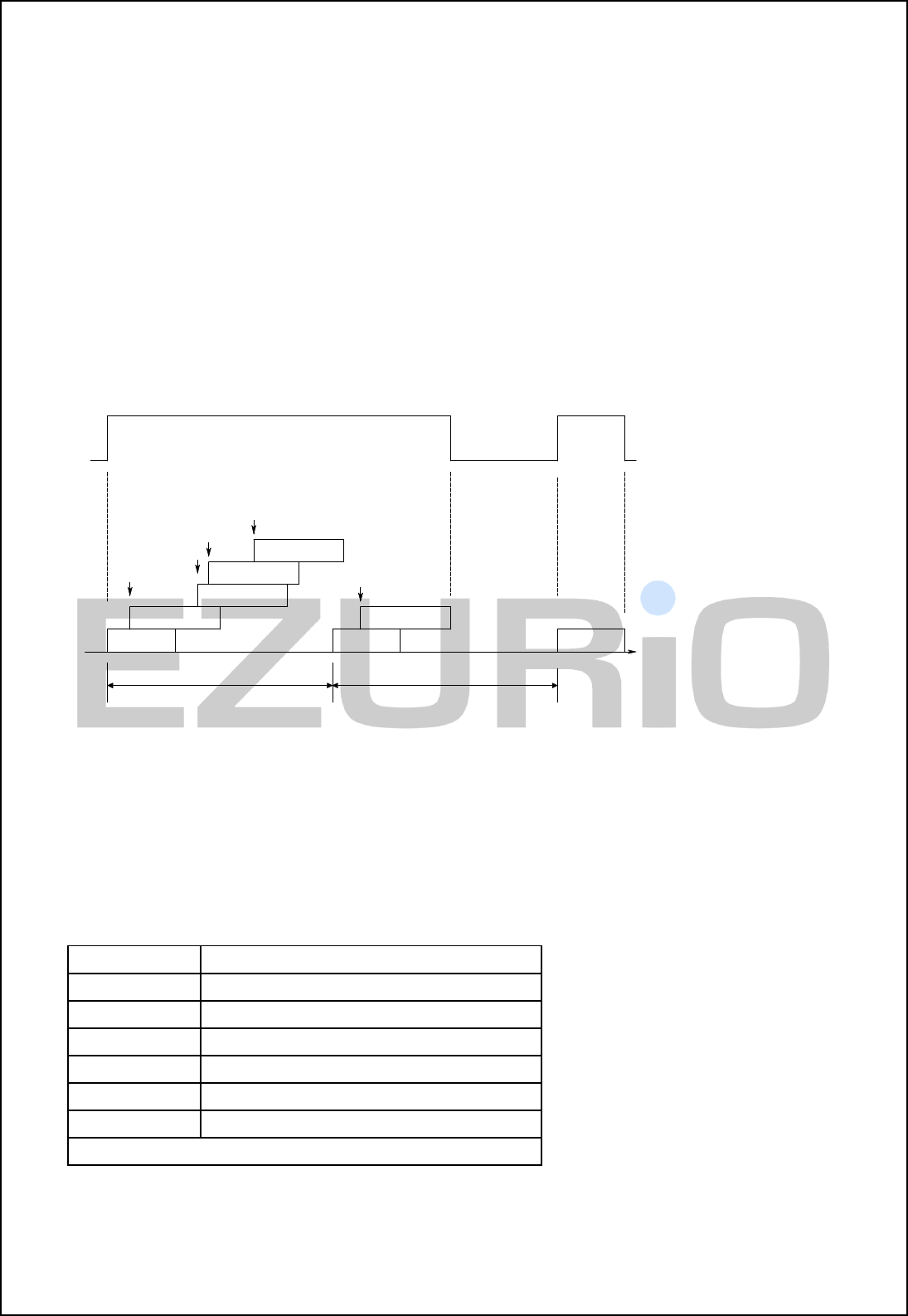
www.ezurio.com DSH_BT024-00200_1v5 © Ezurio Ltd 2006 14
N-M slots, and so can switch its power hungry circuitry off. The specification goes further by also specifying a
third parameter called ‘timeout’ (T) which specifies ‘extra’ timeslots that the slave will agree to listen for after
receiving a valid data packet. Put another way, if a data packet is received by the slave, then it knows that it
MUST carry on listening for at least T more slots. If within that T slot time period another data packet is received,
then the timer is restarted. This mechanism ensures low power consumption when there is no data transfer – at
the expense of latency. When there is a lot of data to be transferred, it acts as if sniff mode were not enabled.
It is stated above that during sniff mode, a slave listens for N slots every M slots. The Bluetooth specification
states that a master can have up to 7 slaves attached to it with all slaves having requested varying sniff
parameters. It may therefore be impossible to guarantee that each slave gets the M parameter it requested. In
light of this, the protocol for enabling sniff mode specifies that a requesting peer specify the M parameter as a
minimum and maximum value. This will allow the master to interleave the sniff modes for all slaves attached.
This is illustrated in the diagram below.
For this reason, the sniff parameters are specified in the Embedded Intelligent Bluetooth Module via four S
registers. S Register 561 is used to specify ‘N’, S Register 562 is used to specify ‘T’ and S Registers 563/564 are
used to specify minimum ‘M’ and maximum ‘M’ respectively. Although the specification defines these parameters
in terms of timeslots, the S register values have to be specified in units of milliseconds and the firmware does the
necessary translation to timeslots.
Data Exhange
High Power Consumption
Low Power Consumption
M
Slots (Negotiated)
M
Slots (Negotiated)
N
Slots
N
Slots
N
Slots
T
Slots
T
Slots
T
Slots
T
Slots
T
Slots
Data Exchange
Data Exchange
Data Exchange
Data Exchange
Data Exchange
9. Application Examples
9.1 RS232 Modem Signals
Just as a telephony modem has control and status lines, the module also provides for 6 control and status lines as
per the table below. The direction column is as seen from the module’s viewpoint.
Direction Function
IN or OUT * CI also known as RI (Ring Indicate)
IN or OUT * DCD (Data Carrier Detect)
IN DSR (Data Set ready)
OUT DTR (Data Terminal Ready)
IN CTS (Clear to Send)
OUT RTS (Request to Send)
* configurable with S register 552
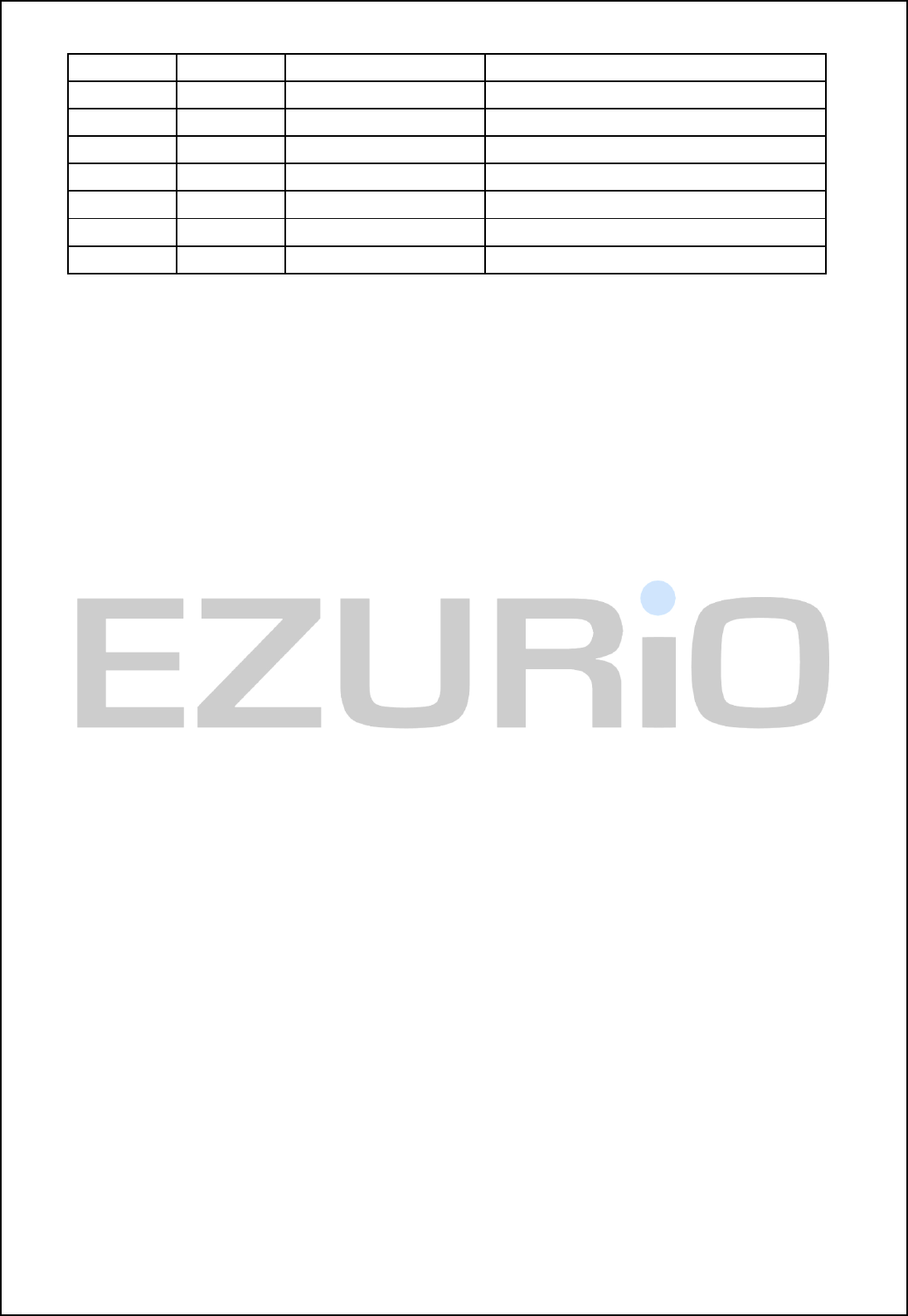
www.ezurio.com DSH_BT024-00200_1v5 © Ezurio Ltd 2006 15
Pin Direction Connector Pin Label Function
27 IN/OUT GPIO_3/UART_DTR General Purpose I/O (or DTR functionality)
36 IN/OUT GPIO_4/LED1 General Purpose I/O (LED1)
35 IN/OUT GPIO_5/LED2 General Purpose I/O (LED2)
6 IN/OUT GPIO_6 General Purpose I/O
7 IN/OUT GPIO_7 General Purpose I/O
38 IN/OUT GPIO_8 General Purpose I/O
34 IN/OUT GPIO_9/PCM_SLVCLK General Purpose I/O (PCM SLAVE CLK)
Notes:
1. UART_DSR is used by the module to sense that the host is connected, and is intricately linked with
connections. For outgoing calls, if this line is not asserted then an error is indicated. Similarly for AT+BTP and
AT+BTG.
While in a call, for appropriate modes, a de-assertion means fall into command state. If the de-assertion exists
for longer than the period specified in S Register 519 then the connection is dropped as if an ATH command was
received.
2. UART_RI, is normally de-asserted. When an incoming connection is detected it will be asserted, until the
connection is either answered or rejected using ATA and ATH respectively. See S Registers 552 & 553 for more
details
3. UART_DCD will be de-asserted when the device is in the unconnected state. Asserted when a connection
is active. See S Registers 552 and 553 for more details.
4. GPIO_3 is either used as GPIO or driven as UART_DTR. When the unit is configured in pure host mode,
this pin is forced into UART_DTR and is asserted when there is a Bluetooth connection.
5. GPIO_9 can be used to generate a PCM clock when both connected modules are in slave mode. Contact
Ezurio for more information.
The GPIO Pins are available for general purpose use.
9.2 Modem signalling over Bluetooth
The RFCOMM protocol used in Bluetooth for implementing the serial port profile allows for the exchange of four
modem signals. This information is contained in a special transparent message which contains bits identified as
RTR, RTC, DV and IC which depending on the type of serial device being emulated maps to DTR or DSR, RTS,
DCD and RI respectively. In addition, this message also includes the ability to convey a BREAK input from one
end to the other.
To allow for the greatest flexibility and variability in how the modem control signals are used in the real world, S
Registers 551, 552 and 553 have been provided which allow for any of RTR, RTC, DV and IC to be mapped to any
modem control/status line.
BREAK signal on RX line
If the host sends a break signal of duration greater than 100ms, then the module is configured to treat
that as a signal to perform a hardware reset.
This being the case it is not possible to convey a BREAK over Bluetooth to the peer device.
A continuous low on the RX line will be treated by the module as a reset (BREAK). Therefore the host
should keep RX high while idling.
Reset
The module can be reset by the host without the need of any I/O using a BREAK signal. The module has
been configured to reset when the RX line detects a break condition for durations greater than 100
milliseconds.
The Reset line has a fixed pull up resistor of 10k Ohm

www.ezurio.com DSH_BT024-00200_1v5 © Ezurio Ltd 2006 16
9.3 Pure Cable Replacement Mode
The module has the capability of being preset into a pure 5-wire data cable replacement mode. The 5 wires being
RX, TX, CTS, RTS and GND. This mode requires no changes to a host application since the Bluetooth connection is
automatically set up on power up. If the connection is lost the Embedded Intelligent Bluetooth Module will
constantly retry until the connection is reinstated.
By implication, two devices are needed to replace a cable. One device is pre-configured to always be a master
and the other, a slave.
Assuming the Bluetooth address of the master to be <bdaddr_m> and that of the slave to be <bdaddr_s>, the
master module is configured by sending it the following AT commands:
AT&F*
ATS512=1
ATS504=1
ATS507=2
ATS530=2000
AT&W
AT+BTR<bdaddr_s>
The ATS507=2 setting puts the device in DSR drop mode only. This means that when the device needs to be
reconfigured, deasserting the DSR line will ensure that the module responds quickly to AT commands. This further
means that in stand alone mode, the DSR input line MUST be asserted e.g. 0V in TTL signal mode.
The slave is configured by:
AT&F*
ATS512=4
ATS0=-1
AT&W
AT+BTM<bdaddr_m>
Where AT+BTM<bdaddr_m> is optional. If it is not specified, then the slave unit will accept connections from any
device. If specified then only connections from the device specified will be accepted.
If it is desired that the slave unit should not be discoverable (the master is by default not discoverable), then the
configuration commands are:
AT&F*
ATS512=3
ATS0=-1
AT&W
AT+BTM<bdaddr_m>
Where AT+BTM<bdaddr_m> is optional. If it is not specified, then the slave unit will accept connections from any
device. If specified then only connections from the device specified will be accepted.
When the units are next power cycled, the slave unit will wait for the master to connect to it and the master will
continually look for the slave. If a connection attempt fails, the master will wait for 2 seconds before reattempting
a connection. This 2 second delay can be varied by issuing it an ATS530 command with an appropriate value in
the range 100ms to 15000ms.
IMPORTANT NOTE: The DSR input to the module MUST be asserted for the auto connection to succeed. When
operating at TTL levels a 0V is seen as an assert state. When operating at RS232 levels and voltage greater than
3V is seen as assert. It is usual to connect the DTR line of the host to the DSR line of this device.

www.ezurio.com DSH_BT024-00200_1v5 © Ezurio Ltd 2006 17
9.4 Audio Cable (voice)
With a pair of these modules it is possible to replace a mono audio cable with two way traffic. That is, a setup
where a microphone is connected to a speaker at the remote end and vice versa. So this mode effectively
replaces two audio cables.
Assuming the Bluetooth address of the master to be <bdaddr_m> and that of the slave to be <bdaddr_s>, the
master module is configured by sending it the following AT commands:
AT&F*
ATS512=1
ATS504=1
ATS530=2000
ATS532=7
AT&W
AT+BTR<bdaddr_s>
And the slave is configured by:
AT&F*
ATS512=4
ATS0=-1
AT&W
AT+BTM<bdaddr_m>
9.5 Modem Control and Status Signals
A serial port has DTR, DSR, RTS, CTS, DCD and RI control lines. RTS and CTS are locally controlled to prevent
local buffer overflow.
The status of DTR, DRS, DCD and RI can be exchanged with the remote peer device. If for example, the
DTR/DSR lines are to be exchanged between the two peers to simulate the performance of a physical cable, then
it is possible to do so. Refer to the description for S Registers 551, 552 and 553 for more details.
Some serial implementations link CTS and RTS to remove the need for handshaking. Ezurio do not recommend
linking CTS and RTS other than for testing and prototyping. If these pins are linked and the host sends data at
the point that the Bluetooth Serial Module deasserts its RTS signal, then there is a significant risk that internal
receive buffers will overflow which could lead to an internal processor crash. This will lead to a drop in connection
and may require a power cycle to reset the module.
Ezurio recommend that the correct CTS/RTS handshaking protocol be adhered to for proper operation.
9.6 Oscillator Output
The output from the high performance crystal oscillator (+ 10ppm) can be divided and output on one of the
selected PIO lines, removing the need for a crystal on the customer’s main pcb. The frequencies available are:
• 8 MHz
• 16 MHz
• 24 MHz
• 48 MHz
For more implementation details, please contact Ezurio’s FAE team.

www.ezurio.com DSH_BT024-00200_1v5 © Ezurio Ltd 2006 18
10. Application Information
10.1 Antenna Position
The antenna used on the Embedded Intelligent Bluetooth module is designed to be largely immune from the
effects of proximity detuning. Normally, antennas operating at 2.4GHz are affected by their surroundings, so that
great care is needed in their placement and orientation.
The Embedded Intelligent Serial Module can be used in most locations and orientations and is only marginally
affected by the presence of a significant ground plane in close proximity.
The antenna distribution is close to isotropic, which means that the orientation of mounting has only a limited
effect on the overall range. However the optimum range is achieved when the two antennae are directly facing
each other
The module should not be located in a sealed metal enclosure, as this will act as a Faraday cage and severely
attenuate the radio signal. A distance of 6mm has been allowed between the metal shield and the antenna to
allow the antenna to protrude through a slow in a metal enclosure.
10.2 Power Supply Considerations
The power supply for the Module has to be a single voltage source of Vcc within the range of 3.3 V to 7.0 V. It
must be able to provide sufficient current in a transmit burst. This can rise to 65mA.
10.3 Power-On-Reset
The Module is provided with an active low reset pin. Upon the application of power, the Power On Reset circuit
built into the Module will ensure that the unit starts correctly. The internal reset circuit is triggered when the
input voltage to the module drops below ~1.7V and is hence only suitable for providing a power on reset signal. If
the supply voltage to the module can drop below the minimum voltage level in normal operation, then it is
recommended that an external brownout circuit is provided to assert the module reset and to ensure that the
module is reset when the module supply voltage drops below 3.1V.
This will ensure that the module will return to an operational state when the supply voltage comes back within
specification. For example, if the module supply can drop to 2.7V and then be restored to 3.3V there is no
guarantee that the module will still be operational unless the reset signal has been asserted.
10.4 RF Shield
To meet FCC requirements and to facilitate IR soldering, all modules are supplied with a soldered RF shield. This
meets the requirement that users may not be able to access RF circuitry without special tools. Removal of the
shield may negate RF approvals.
10.5 Mounting the Module onto the application platform
The antenna (Brown square component on top side of PCB) is designed to minimise detuning effects from nearby
components and metalwork. However, it is good design practise to ensure that other active circuitry is kept away
from the antenna.
The proximity of the antenna to large metallic objects can affect the range and performance of the system.
Designers should carefully consider the location of the Module and the type of enclosure material that is used.
No tracks should be present on the top layer of the board on which the module is soldered, as these may cause
inadvertent connections to test pads. The recommended land pattern for the mother PCB is detailed below
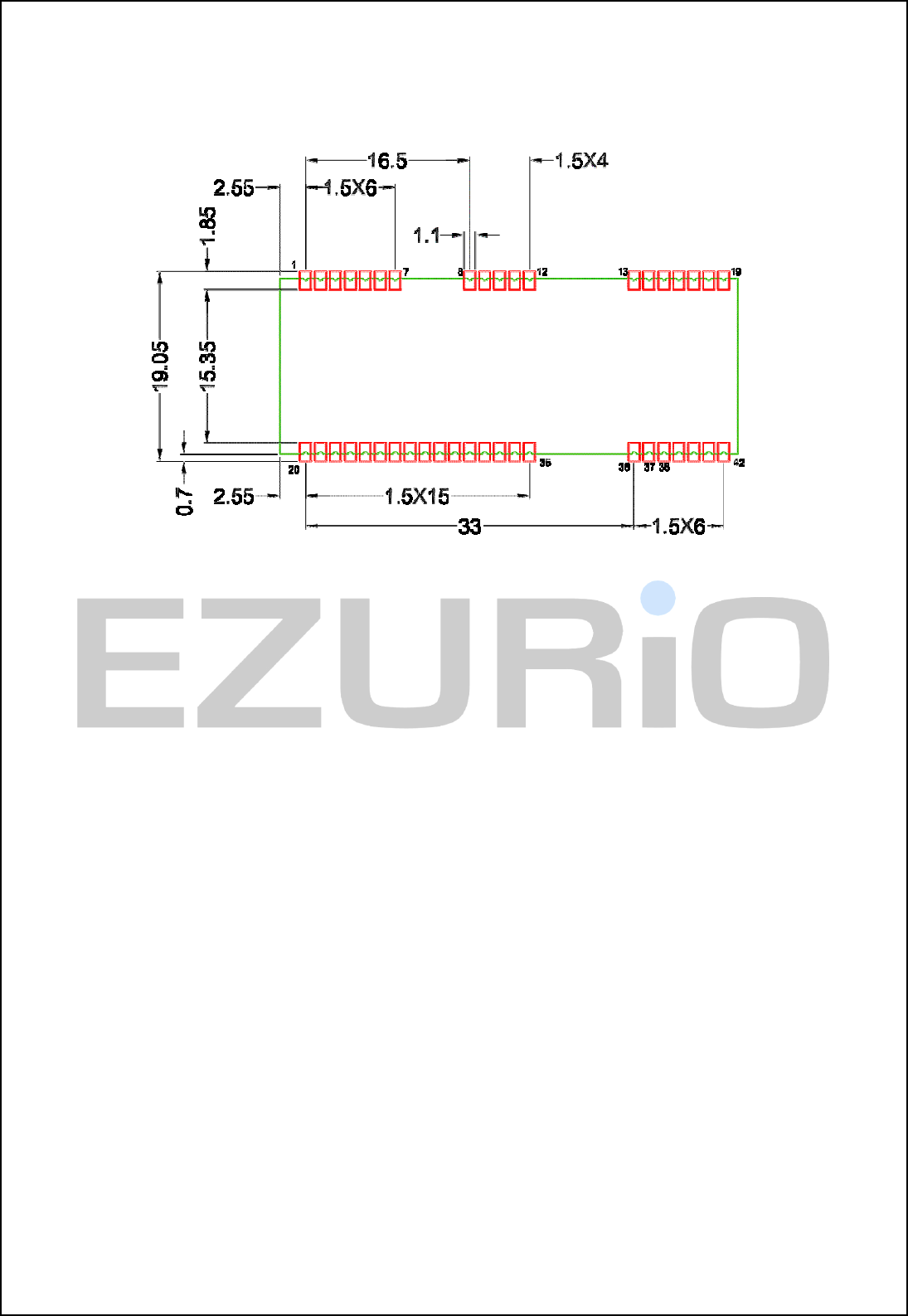
www.ezurio.com DSH_BT024-00200_1v5 © Ezurio Ltd 2006 19
Notes: The motherboard should have no copper, solder resist or tracks beneath the module on the pad layer.
N/C Pins should have no electrical connection, including to other N/C pins, but be mechanical pads only.
11. Qualification
11.1 Bluetooth Qualification Process
The following safety precautions must be observed during all phases of the operation, usage, service or repair of
any application incorporating this Module. Manufacturers of the RF equipment are advised to convey the following
safety information to users and operating personnel and to incorporate these guidelines into all manuals supplied
with the product. Failure to comply with these precautions violates safety standards of design, manufacture and
intended use of the product. Ezurio assumes no liability for customer failure to comply with these precautions.
11.2 Safety Information:
Switch off the Bluetooth device before boarding an aircraft. Make sure it cannot be switched on inadvertently. The
operation of wireless appliances in an aircraft is forbidden by many airlines to prevent interference with
communications systems. Applications that could result in use on aircraft should carry appropriate warnings.
11.3 Qualifications
11.3.1 RF approvals
The Module is listed as a Bluetooth Product in terms of the Bluetooth SIG Program Reference Document (PRD).
This means that it can be integrated into end products without further testing or approval listing. The
manufacturer must state the Ezurio part number and product reference in his literature in order to meet the
requirements of the Bluetooth and regulatory approvals.
A list of the countries where the Module is approved will be provided by Ezurio as required. As a minimum the
product is listed in Europe, Scandinavia and USA. Ezurio assumes no liability for customer failure to comply with
national RF approvals.

www.ezurio.com DSH_BT024-00200_1v5 © Ezurio Ltd 2006 20
11.3.1.1 Radio.
EN 300 328 V1.5.1 (2004 – 08)
EN 301 489 – 1 V1.4.1 (2002 – 08)
EN 301 489 – 17 V1.2.1 (2002 – 08)
11.3.1.2 EMC Emissions.
FCC15B Class B
EN55022 Class B
11.3.1.3 EMC Immunity.
EN55024 Class
11.3.1.4 Environmental.
EN300 019-2-4 v2.2.2 (2003-2004)
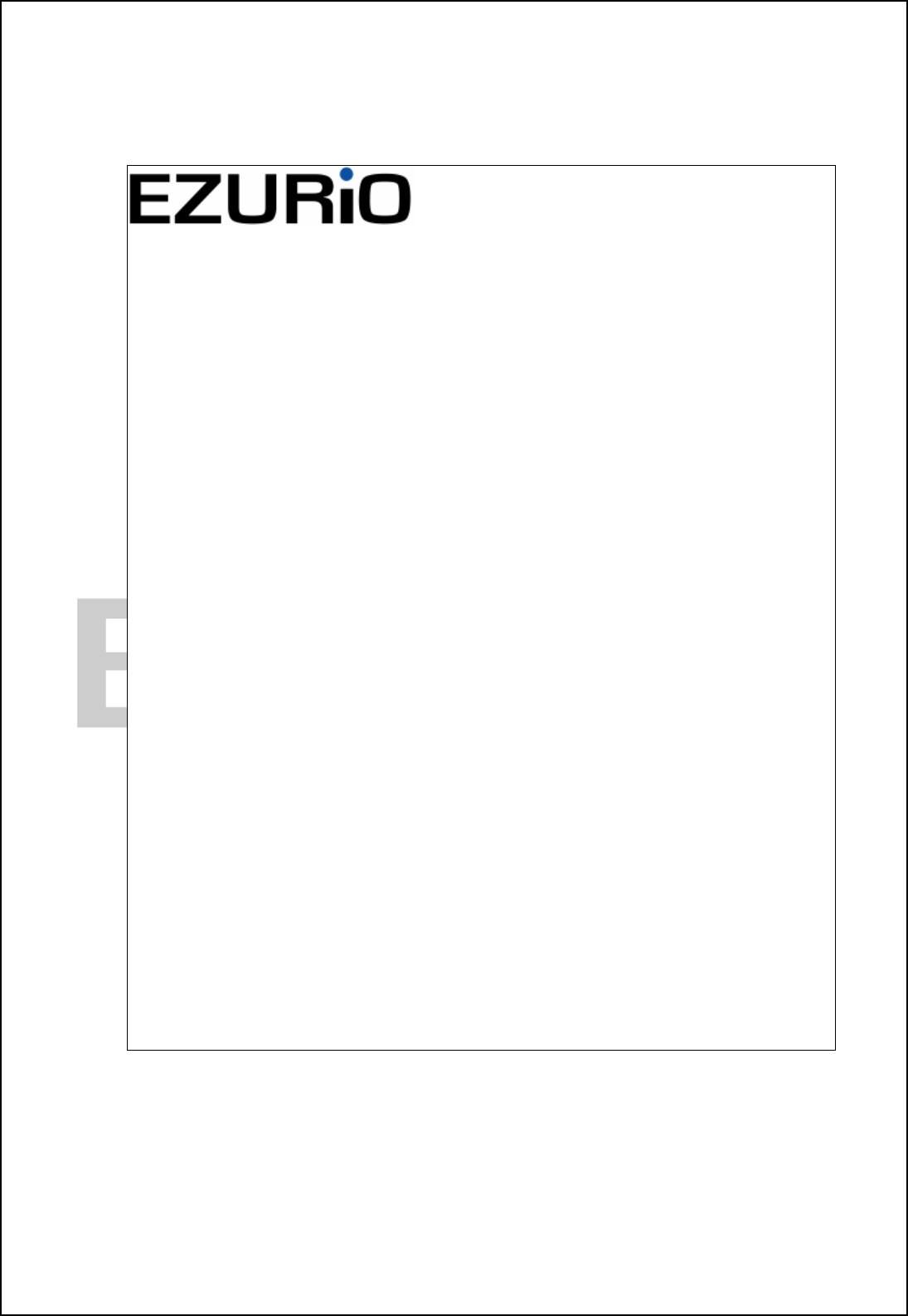
www.ezurio.com DSH_BT024-00200_1v5 © Ezurio Ltd 2006 21
11.4 Safety and Regulatory Statements
11.4.1 Europe – EU Declaration of Conformity
DECLARATION OF CONFORMITY
In accordance with Annex IV of the EU directive 1999/5/EC
Ezurio declare under our responsibility that the Bluetooth Module
complies with the appropriate essential requirements of the Article 3 of the R&TTE and the
other relevant provisions, when used for its intended purpose.
Health and Safety requirements contained in Article 3 (1) a)
EN 60 950: 1992 Safety of information technology equipment + Amendment A1:1993,
Amendment A2:1993, Amendment A3:1995, Amendment A4:1997, Amendment A11:1997
EN 50371: Generic standard to demonstrate the compliance of low-power ele
ctronic and
electrical apparatu
s with the basic restrictions related to human exposure to
electromagnetic fields (10 MHz - 300 GHz) – General public
Protection requirements with respect to electromagnetic compatibility Art.3 (1) b)
EN 301 489-1 V1.4.1 (2002-08) according to the specification details in EN 301 489-
17
V1.2.1 (2002-08
), Electromagnetic Compatibility and radio spectrum Matters (ERM);
Electro Magnetic Compatib
ility (EMC) standard for radio equipment and services; Part 17:
Specific conditions for wideband data HiperLAN equipment
Means of the efficient use of the radio frequency spectrum
EN 300 328 V1.5.1 (2004 – 08)
, Radio Equipment and Systems (RES); Wideband
transmission systems; Technical characteristics and test conditions for data transmission
equipment operating in the 2,4 GHz ISM band and using spread spectrum modulation
techniques. Part 2: Harmonized EN covering essential requirements under article 3(2)
of
the R&TTE directive.
Ezurio Ltd tel: +44 (0)20 8938 1000
Unit 2, 126 Colindale Avenue, Colindale fax: +44 (0)20 8905 8608 Registered in England
London NW9 5HD, United Kingdom www.ezurio.com No. 5178293
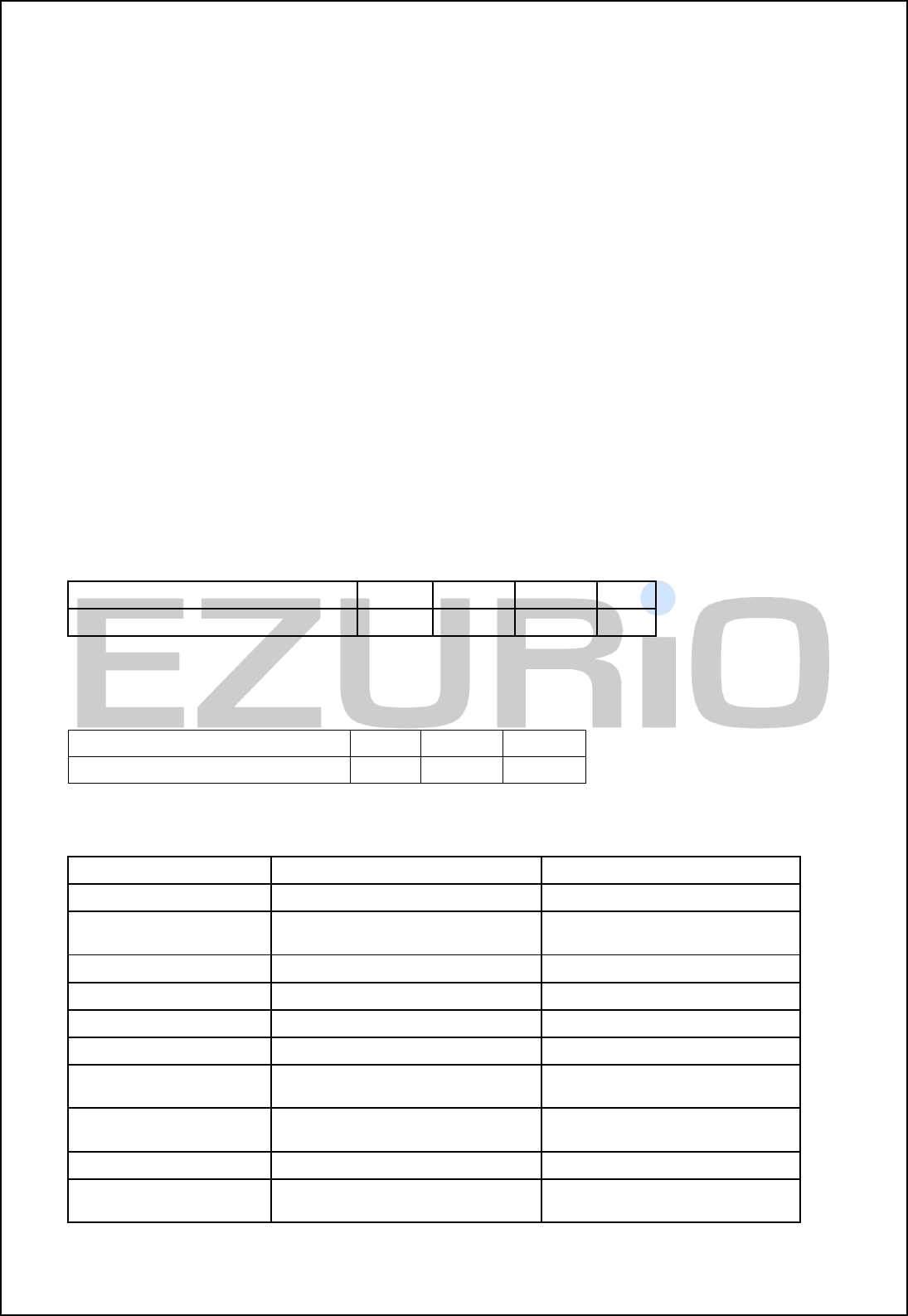
www.ezurio.com DSH_BT024-00200_1v5 © Ezurio Ltd 2006 22
11.4.2 FCC and Industry Canada Statements
This device complies with part 15 of the FCC Rules. Operation is subject to the following two conditions: (1) This
device may not cause harmful interference, and (2) this device must accept any interference received, including
interference that may cause undesired operation.
Changes or modifications not expressly approved by the party responsible for compliance could void the user's
authority to operate the equipment.
To comply with the FCC RF exposure compliance requirements, this device and its antenna must not be co-located
or operated in conjunction with any other antenna or transmitter.
11.4.2.1 FCC Labelling requirement
If the FCC ID is not visible when the module is installed inside another device, then the outside of the device into
which the module is installed must also display a label referring to the enclosed module. This exterior label can
use wording such as the following: “Contains Transmitter Module FCC ID: PI403B” or “Contains FCC ID: PI403B.”
Any similar wording that expresses the same meaning may be used.
12. Environmental
12.1 Operating temperatures
12.2 Storage temperature
12.3 Reliability
Parameter Test Comment
Thermal Shock 200 cycles -40ºC /+85ºC 30 min 1 cycle/hour
Vibration Continuous operation at 60 Hz, 2mm
stroke
15g max sine wave, 12 hours
Shock 50G 11ms Half Sine Wave 6 axis x 3 cycles each axis
Moisture Resistance
High Temp Storage 125ºC, 360 hours
Low Temp Storage -40ºC, 240 hours
High Temp/Humidity
Operation
60ºC, 90%RH, 360 hours
Thermal shock -40 to 60ºC in 30min 200 cycles with continuous
operation
Electro Static Discharge EN55024:1998 & IEC61000-4-3
Drop Test 75cm to concrete, 3 axis x 2 cycles
per corner
Parameter Min Typ Max Unit
Operating temp (standard product) -40 25 +85 °C
Parameter Min Max Unit
Storage temp -40 +125 °C
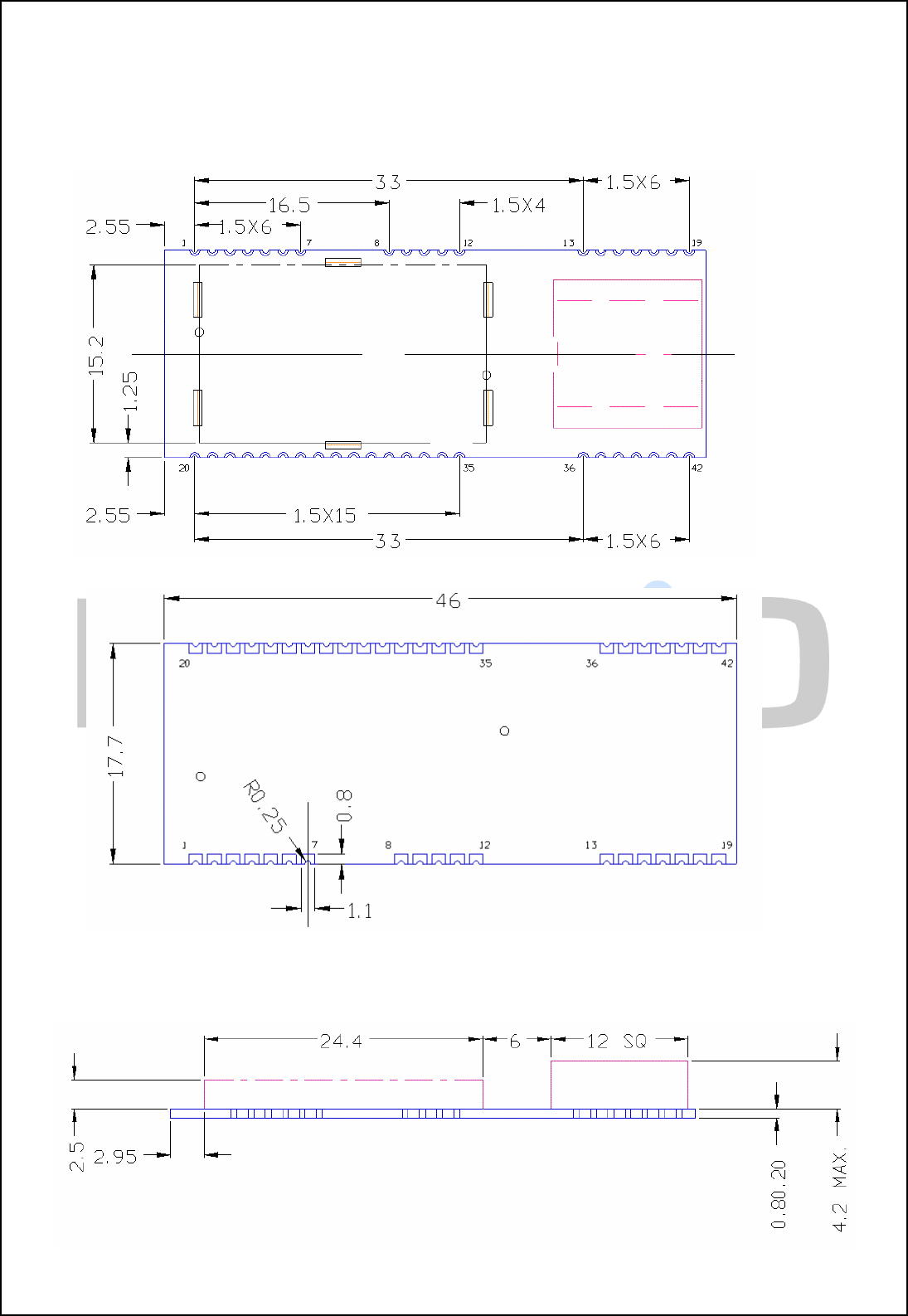
www.ezurio.com DSH_BT024-00200_1v5 © Ezurio Ltd 2006 23
13. Physical Dimensions (all dimensions in mm)
13.1 Top View
13.2 Bottom View
13.3 Side View
13.4 Labelling
The shielding can indicates the part number and the unique Bluetooth address of the module.
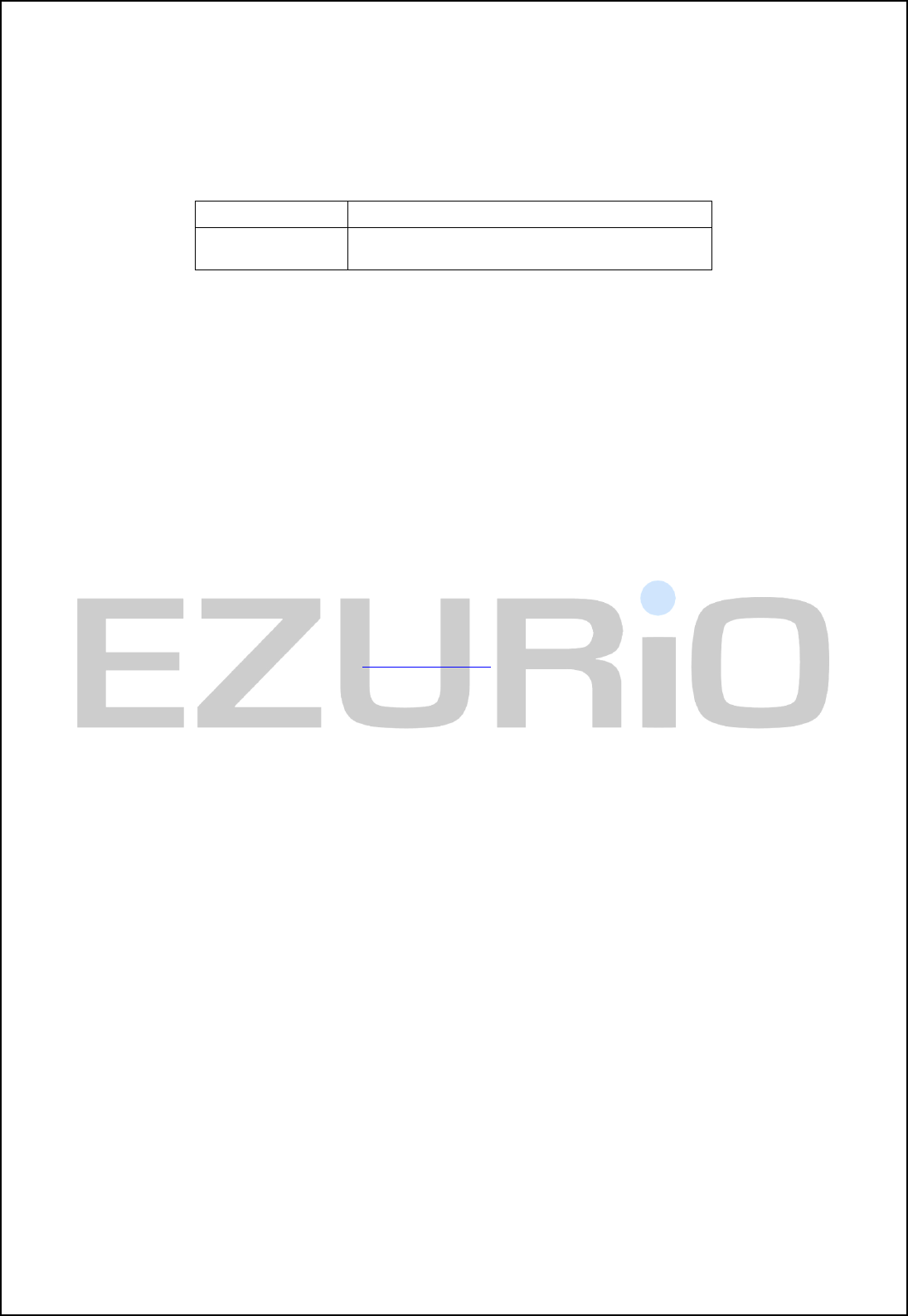
www.ezurio.com DSH_BT024-00200_1v5 © Ezurio Ltd 2006 24
13.5 Ordering Information
The Embedded Intelligent Serial Module is available with different variants of production firmware. Ordering
information is provided below:
Part Number Description
TRBLU024-02 Embedded Module with integrated ceramic antenna
and standard AT firmware
14. Related Documents
The firmware incorporated into the Embedded Intelligent Bluetotoh Module is the same as that for the BISM2
Module. All of the firmware documentation and application data for the BISM2 module can be used for this
module.
• blu2i AT Command Set Reference Manual
• blu2i Firmware Release Notes
• blu2i Multipoint Firmware Reference Manual
• Intelligent Bluetooth Serial Module - Quick Start Guide
• Intelligent Bluetooth Serial Module - FAQ
• blu2i Application Scenarios
• Bluetooth Core 2.0 Specification – www.Bluetooth.org
15. Disclaimers
EZURIO’S BLUETOOTH PRODUCTS ARE NOT AUTHORISED FOR USE AS CRITICAL COMPONENTS IN LIFE SUPPORT
DEVICES OR SYSTEMS WITHOUT THE EXPRESS WRITTEN APPROVAL OF THE MANAGING DIRECTOR OF EZURIO
LTD.
The definitions used herein are:
a) Life support devices or systems are devices which (1) are intended for surgical implant into the body, or (2)
support or sustain life and whose failure to perform when properly used in accordance with the instructions for
use provided in the labelling can reasonably be expected to result in a significant injury to the user.
b) A critical component is any component of a life support device or system whose failure to perform can be
reasonably expected to cause the failure of the life support device or system, or to affect its safety or
effectiveness.
Ezurio does not assume responsibility for use of any of the circuitry described, no circuit patent licenses are
implied and Ezurio reserves the right at any time to change without notice said circuitry and specifications.
15.1 Data Sheet Status
This data sheet contains data from the Preliminary specification. Supplementary data will be published at a later
date. Ezurio Ltd reserve the right to change the specification without notice in order to improve the design and
supply the best possible product.
Please check with Ezurio Ltd for the most recent data before initiating or completing a design.

www.ezurio.com DSH_BT024-00200_1v5 © Ezurio Ltd 2006 25
15.2 Warranty
Ezurio warrants that its products shall conform to Ezurio’s published specifications and remain free from defects in
materials and workmanship under normal, proper and intended use for a period of two (2) years from date of
purchase, provided that proof of purchase be furnished with any returned equipment.
If during the warranty period any component part of the equipment becomes defective by reason of material or
workmanship, and Ezurio is immediately notified of such defect, Ezurio shall at its option supply a replacement
part or request return of equipment, freight prepaid, to its designated facility for repair. In the event no trouble is
found on products returned for repair, Ezurio reserves the right to charge the customer its standard published
repair charge.
This warranty shall not apply to any products that have been subject to misuse, bending, twisting, neglect,
alteration, improper installation, testing or unauthorized repair performed by anyone other than an Ezurio
designated repair facility. Any non-warranty repairs or maintenance shall be at Ezurio’s standard rates in effect at
the time.
This warranty is in lieu of all other warranties, whether expressed, implied, or statutory, including but not limited
to, implied warranties or merchantability and fitness for a particular purpose. In no event shall Ezurio be liable,
whether in contract, in part, or on any other basis, for any damage sustained by its customers or any other
person arising from or related to loss of use, failure or interruption in the operation of any products, or delay in
maintenance, or for incidental, consequential, in direct, or special damages or liabilities, or for loss of revenue,
loss of business, or other financial loss arising out of or in connection with the sale, lease, maintenance, use,
performance, failure, or interruption of these products.
The equipment has been tested and found to comply with the limits for a Class B Digital Device, pursuant to part 15 of the
FCC Rules. These limits are designed to provide reasonable protection against harmful interference in a residential
installation. This equipment generates, uses and can radiate radio frequency energy and, if not installed and used in
accordance with the instruction, may cause harmful interference to radio communication. However, there is no grantee that
interference will not occur in a particular installation. If this equipment dose cause harmful interference to radio or television
reception, which can be determined by turning the equipment off and on , the user is encouraged to try to correct the
interference by one or more of the following measures:
--Reorient or relocate the receiving antenna.
--Increase the separation between the equipment and receiver.
--Connect the equipment into an outlet on a circuit different from that to which the
receiver is connected.
--Consult the dealer or an experienced radio/TV technician for help.
To OEM installer:
1. FCC ID label on the final system must be labeled with "Contains FCC ID: PI403B" or "Contransmitter module FCC ID:
PI403B".
2.In the user manual, final system integrator must be ensure that there is no instruction provided in the user manual to install
or remove the transmitter module.
3. Transmitter module must be installed and used in strict accordance with the manufacturer is instructions as described in
the user documentation that comes with the product. This device complies with the following radio frequesny and safety
standards.
The user manual of the final host system must contain the following statements:
USA-Federal Communication Commission (FCC)
This equipment has been tested and found to comply with the limits for a Class B Digital Device, pursuant to part 15 of the
FCC Rules. These limits are designed to provide reasonable protection against harmful interference in a residential
installation. This equipment generates, uses and can radiate radio frequency energy and, if not installed and used in
accordance with the instruction, may cause harmful interference to radio communication. However, there is no grantee that
interference will not occur in a particular installation. If this equipment dose cause harmful interference to radio or television
reception, which can be determined by turning the equipment off and on , the user is encouraged to try to correct the
interference by one or more of the following measures:
--Reorient or relocate the receiving antenna.
--Increase the separation between the equipment and receiver.
--Connect the equipment into an outlet on a circuit different from that to which the
receiver is connected.
--Consult the dealer or an experienced radio/TV technician for help.
This device complies with Part 15 of the FCC Rules. Operation is subject to the following two conditions: (1) this device may
not cause harmful interference, and (2) this device must accept any interference received, including interference that may
cause undesired operation.
The changes or modifications not expressly approved by the party responsible for compliance could void the user’s authority
to operate the equipment.
To comply with the FCC RF exposure compliance requirements, this device and its antenna must not be co-located or
operating to conjunction with any other antenna or transmitter.